|

by Richard C. Hoagland
2008
from
EnterpriseMission Website
Part I
A half-century ago, from a windswept
Florida beach, the United States finally "got back in the game" -
after the shock of the Soviet Union's Sputnik just three months
earlier - and successfully launched its own satellite into an orbit
of the Earth... dubbed after launch, "Explorer I."

Unknown to anyone but a handful of
civilian engineers and US Army personnel, intimately involved with
the launch that night, this would became a true "history-defining
moment" - when the launch team, via Explorer I, immediately and
serendipitously made America's MOST important and overarching
discovery, of all nations that would someday ever venture off the
Earth... in the entire fifty-year history of "space"...
The secret of gravity and inertia themselves... revealed as a true
"anti-gravity effect" - somehow operating on Explorer I... radically
affecting its very orbit!
A seminal discovery... which - at the stroke of a White House pen -
could have re-written not only the history of science… but, the
destiny of the entire world...
However, this was not to be.
This monumental, history-making breakthrough was immediately
followed by the United States' most far-reaching political move of
this same half-century - a hurried decision, made apparently that
same night, to keep this phenomenal "anti-gravity" discovery a
total secret... not only from its own civilian scientists, its own
"free press"... its own citizens and taxpayers... but, from everyone
on Earth!
This is the story of the Enterprise Mission's painstaking,
years-long investigation (given context in our recent New York Times
bestseller -
Dark Mission: the Secret History of NASA):
the
"back-engineering," scientific and political analysis of this
"world-changing, pre-NASA discovery"... and the grave global
consequences that have now evolved from the crucial decision, made
by "someone" in a position of Authority that night... to simply... "bury it."
In subsequent pages, we will detail and document "who" exactly made
this amazing breakthrough, precisely "how" it was achieved, and
"what" the stunning, world-wide implications could have been... if
science had been allowed to take its natural course that night - if
this unique discovery had been freely presented, freely studied and
freely discussed in the global scientific community in the ensuing
years... and then, implemented as a revolutionary, Earth-based
"gravitational control technology."
But, most important..., we will detail how this paradigm-shattering breakthrough can now be
duplicated - by any student, in any decent high school physics
laboratory... literally, anywhere on Earth!
And what that now could mean for all Humanity.
Explorer I was launched at 10:48 PM EST, January 31, 1958 - from Pad
26A, at Cape Canaveral.
The Jupiter-C rocket (C standing for "composite") that successfully
launched this first US satellite into the Florida skies (below), was
actually a converted "Redstone" military ICBM - a rocket developed
as a US Army advancement over their earlier "V-2s," by Wernher von
Braun and his imported team of "Operation Paperclip" German Nazi
rocket engineers to the United States, in the decade immediately
following World War II.

This "Jupiter-C satellite launcher" was
built around a main liquid-fueled rocket stage, composed of two
separate tanks for housing liquid oxygen and the "Hydyne"
hydrazine-based fuel, standing a total of 47 feet high and weighing,
fully loaded, 62,700 pounds.
Atop this "main stage" were 15 individual, much smaller solid
propellant rockets, arranged in three additional "stages" (weighing
a total of 1380 pounds), consisting of 11, 3 - and finally, 1 -
topped, at 71 feet above the ground, by the ~31-lb, bullet-shaped
Explorer I satellite itself (below) - literally bolted to the fnal
"solid" stage beneath it.

Explorer I's best-known, unclassified
contribution to space science was the discovery of the famed “Van
Allen” radiation belts - named for the University of Iowa physicist,
James van Allen, who first found (via his radiation detectors aboard
Explorer I, confirmed by the two successor Explorer III and IV
spacecraft) the high-energy “donuts” of charged particles circling
the Earth, trapped by its "dipole" magnetic field (below).
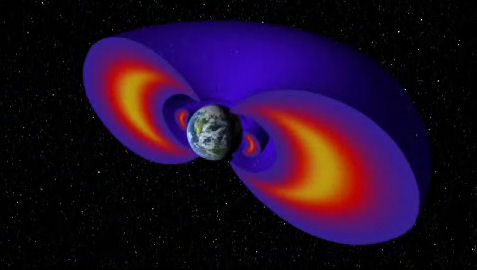
Van Allen went on to win the equivalent
of the “Nobel space physics prize” for this fundamental space
discovery - which was eventually found to be a basic feature of ALL
planets in (and outside) the solar system exhibiting similar
magnetic fields.
He even made it to the cover of TIME magazine.

By stark contrast, the ultimately far
more significant (literally "physics-shattering" - as you shall see)
anomalous orbital dynamics exhibited by this same satellite, and, on
its very first orbit that night...
That, Explorer I’s actual trajectory, unambiguously (and most
disturbingly) seemed to violate two basic laws of 20th Century
Physics, immediately after launch..., have received NO scientific acknowledgements, prizes, or
peer-reviewed discussions… even fifty years after their totally
unexpected discovery...
So, "who" made this remarkable discovery... and then (as the
evidence will prove...) actively participated in its subsequent,
deliberate, decades-long (and still on-going) cover-up?
Why - none other than
Wernher von Braun, himself...
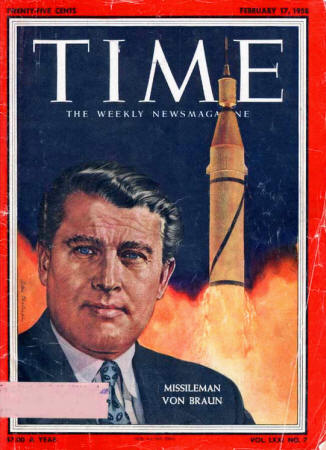
To fully understand the extraordinary
technical and political significance of what "mystifyingly" occurred
that January night in 1958, one has to go back to the events
themselves, swirling around this "super-charged, US Army launch
attempt by von Braun and his German team..." - a desperate effort
for the US to "catch up" in a space race it was clearly still losing
to the Soviets at that point - and compare what was expected to
happen with Explorer I's launch... with what actually happened.
Because of the extremely primitive status of the "global satellite
tracking network" in 1958, required to follow a satellite in orbit,
the number of "stations" up and running the night Explorer I was
finally launched was "few and far between".
The portion of this
Mercator-projection map (below) NOT shaded, is the latitude coverage
straddling the equator dictated by the planned inclination of the
first US satellites - Vanguard and Explorer - designed for orbits
between "latitudes 40 degrees north and south."
As you can see, most
of the existing ground stations were concentrated along a band
running raggedly north and south, mostly in the Americas - heavily
favoring one side of the planet but leaving the rest of the world
"dark" (the scattering of stations seen in other parts of the world
- such as the one in central Australia - did not yet have the proper
equipment to detect Explorer I's radio frequencies, having been
originally planned to support the Navy's Vanguard Program).
Explorer I was launched by von Braun and his team with an orbital
inclination of "33.3 degrees..."

Thus, when the spacecraft disappeared
over the South Atlantic horizon from Cape Canaveral that evening,
after being launched "downrange" (the line extending southeast from
Florida - above), there was essentially no way for von Braun (or
anyone else...) to track it, to KNOW from "telemetry" (radioed
information...) if "his" satellite had been successfully placed in
orbit by the Jupiter C... or not...
But to impatiently just wait..., until Explorer I - moving at ~18,000 miles per hour (5 miles per
second...) - had almost completely circled the entire world... and
came back around... within range of special radio receivers set up
in the deserts just north of San Diego, California (a place called
menacingly "Earthquake Valley"...).
There, if the receivers picked up Explorer I's faint telemetry
signals as it was coming over the Pacific Ocean for the first time -
after the spacecraft had almost circled the entire planet - word was
to be "flashed" (by "long-distance telephone" - as it was quaintly
called in those days...) to Cape Canaveral (where von Braun's Army
launch crew was nervously waiting...), and, to the Pentagon in
Washington DC - where von Braun himself, Van Allen, and William
Pickering (Director of the Jet Propulsion Laboratory - JPL - the
West Coast facility which had constructed the actual satellite) -
were also watching "the clock tick down the seconds"...
If the eventual word from Earthquake Valley was "go," the three
scientists were then scheduled to begin a live press conference over
at the National Academy of Sciences, and announce triumphantly to an
equally waiting world...
"We did it!"
Only after all this "waiting and nail biting"... a literally
hours-long vigil, and an equally archaic mode of communicating
"success" when it was finally learned (over a single telephone line
- stretching between California and Washington DC...) - would (or
could!) anyone in the rest of the world that night really KNOW that
Explorer I had successfully made it into orbit!
That key California signal - for a carefully planned,
Explorer I
trajectory around the Earth of 220 by 1000 miles - was expected at
about 12:30 AM EST, February 1, 1958 (below).

Slightly over an hour and a half after
Explorer's launch from Florida," the moment of truth" in this
intensely anticipated "window" came... and went... and...
nothing.
Then - it was 12:31... then, 12:32... and more nothing.
Because of the "clockwork" nature of satellite orbits when, by
12:33, there was STILL no signal... it became dreadfully apparent to
von Braun's entire senior team - General John B. Medaris, head of
the Army Ballistic Missile Agency (ABMA) which had actually launched
Explorer I for the US Army earlier that night (below)...

And... William Pickering... Director of
the Cal Tech laboratory (JPL) under contract to ABMA for the actual
design and construction of Explorer I (below)...
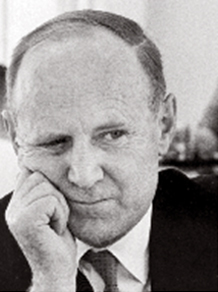
That, they were likely never going to
hear that desperately hoped-for signal... because, somehow...
"something" had gone radically wrong!
By 12:41 AM it was all but certain.
Instead of going into orbit and coming around the Earth on time,
Explorer I had - somehow - been plunged back into the atmosphere far
over the horizon from the Cape - and, by now, had simply burned
up... literally, somewhere on the far side of the world...
It was never going to "come around the Earth and over Earthquake
Valley..." - because it no longer even existed!
A photograph of von Braun (below) - snapped while he and everyone
else at the Pentagon desperately awaited word... any word - captures
perfectly what he was obviously fearing...

Von Braun would later directly write
about his roller coaster emotions during that "interminable wait,"
in a piece entitled "The Story Behind the 'Explorers,'" appearing in
the Des Moines Sunday Register, April 13, 1958:
“... the bird was due in California
about 12:30 A.M., EST. We had four tracking stations there
poised to pick up its signal, and Bill [Pickering] had them on
the long-distance phone.
“Twelve-thirty came. There was no signal.
“A minute went by. And another. And another, without a beep from
the satellite. Eight minutes elapsed and still they didn’t hear
a thing.
“We were miserable. Obviously, we’d been mistaken. The Explorer
had never really gone into orbit..."
Then, at 12:42 AM... there it was!
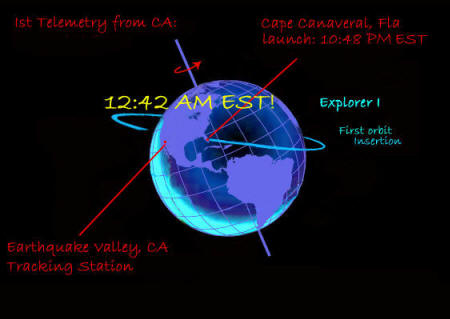
Within the next 30 seconds, all four
Earthquake Valley stations picked up Explorer I's transmitted
signals "loud and clear."
The United States was - finally - in orbit!
Explorer I had just been "late."
But... why?
George Ludwig - Van Allen's chief assistant, and designer of the ~18
pounds of batteries and custom-made radiation-monitoring equipment
on-board Explorer I -
described his own automatic first reaction...
"... we all realized immediately
that the rocket had provided a larger than expected thrust,
resulting in a higher than planned orbit, and a longer orbital
period. The orbit had been expected to have a perigee (lowest
height above the Earth) of about 220 miles and an apogee
(greatest height) of about 1000 miles.
The perigee and apogee heights were
actually 223 miles and, more significantly, 1592 miles,
respectively, with an orbital period of 114.7 minutes rather
than the 105 minutes that had been originally anticipated..."
With the (belated!) acquisition of
Explorer I by Earthquake Valley - von Braun, Van Allen and Pickering
were whisked from the Pentagon to the more "scientific" (and
civilian...) "National Academy of Sciences" - for a packed "2:00 AM
press briefing..."
Amid all the adulation and congratulations, this iconic photograph
(below) was taken, capturing the mood of "a new US technological and
political renaissance" - symbolized now by the resounding success of
Explorer I - in the face of the Soviet Union's "daunting early wins"
in this new game...

Lost in all the well-deserved
self-congratulations... was the nagging real reason for Explorer I's
agonizing delay at Earthquake Valley: its "higher than planned"
orbit.
And... any serious questioning - either from the assembled
scientists that night, or from the press - as to how something like
that could even have been achieved... powered only by von Braun's
relatively primitive "Jupiter-C" rocket...
Van Allen (below) -
when he wrote about his own emotional experience
that memorable night - also barely touched upon "the problem"...

" … the burning of all four stages
[after launch] was monitored by down-range stations and judged
to be nominal. The final burnout velocity of the fourth stage
was somewhat higher than intended, and there was a significant
uncertainty in the final direction of motion. Hence, the
achievement of an orbit could not be established with confidence
from the available data.
The telemetry transmitter was
operating properly, and the counting rate data from our
radiation instrument corresponded to expectations… The reception
of the telemetry signal after the lapse of [almost] one orbit
was necessary before success could be confirmed...
"... for about an hour following receipt of the [last]
down-range station reports, there was an exasperating absence of
information... The clock ticked away, and we all drank coffee to
allay our collective anxiety. After some ninety minutes, all
conversation ceased, and an air of dazed disappointment settled
over the room. Then, nearly two hours after launch, a telephone
report of confirmed reception of the radio signal by two [sic]
professional stations in Earthquake Valley, California, was
received. The roomful of people exploded with exultation, and
everyone was pounding each other on the back with mutual
congratulations..."
Van Allen - NOT being a true "rocket
scientist" (he was, after all, primarily a physicist - specializing
in custom-designed instrument payloads for sounding rockets... not
the launch vehicles themselves) - can be forgiven for not
immediately appreciating the deeper implications of the problem
presented by Explorer I's inexplicable, significantly
higher-than-planned orbit that night.
He could only assume (as,
apparently George Ludwig did... and everyone else) that the "higher
orbit" was the by-product of a "slightly greater efficiency" -
somewhere in von Braun's pioneering, multi-staged Jupiter-C launch
vehicle - most likely, in the solid-fueled rockets, designed by JPL
(in addition to the satellite), that comprised those critical last
three upper stages...
As we have detailed in "Dark Mission," in the chapter devoted to the
remarkable history of one of JPL's key founders - Jack Parsons, and
his early solid-fuel rocket pioneering - "solids" in this period
were only slightly more predictable than "alchemy"... or "magik";
depending on a variety of arcane chemical and physical variables -
the exact proportions of fuel to oxidizer mixed together; the
physical size of the propellant grains of that resulting mix.
The
density of the final packing of those grains into the rocket's
casing, even the temperature of the propellant - any one of these
parameters could affect the final product, which would result in a
well-known "variable thrust and burn time" for all solid-fueled
rockets of the period...
Parson's singular claim to fame was, by exhaustive trial and error,
over more than two decades (from the 1930's through the 1950's...),
to finally have hit upon a fuel/oxidizer mixture, and a loading
process, which eliminated almost all these inherent solid-rocket
variability’s... almost.
For these well-known reasons (to those who "hung around the
fledgling space program..."), it was assumed by all the "non-rocket
scientists" (and by the press...) that one of these "normal
variables" in the Jupiter-C's upper stages easily accounted for the
rocket's additional performance...
That "everyone assumed" this was the case, is obvious... because, it
is equally obvious that no one at the time (at least, anyone who
will talk...) actually sat down and carried out even the most basic
of "rocket calculations" - of just how "over efficient" von Braun's
Jupiter-C had to have been... to result in anything even approaching
Explorer I's much higher-than-expected orbit!
Fifty years after the fact, we have done those calculations... with
some spectacular and very thought-provoking results.
OK, now comes the part where the "mathematically challenged" (or
squeamish...) might want to turn away. If you do, we promise we'll
summarize the cool stuff - in neat, plain English - at the end...
Because...
The foundation of all true "rocket science" is...
The “Rocket Equation!”
Wp = Wi * (1 - e**(-dV/g*ISP))
Where,
Wp = weight of propellant expended during the thrust arc
Wi = initial weight of the vehicle
V = delta velocity change
g = Earth's gravitational acceleration (32.174 ft/sec^2)
ISP = specific impulse of the engine (and fuel) in use
Solving for dV (the final rocket velocity), the equation
becomes:
dV = -g*ISP*ln(1- Wp/Wi)
Back to English.
Broken down, the above equation is actually quite simple.
The key parameter is the number representing "ISP" - a rocket's
"specific impulse" (expressed as "seconds").
Specific impulse is somewhat like a "miles per gallon" reading for
your car; the higher the specific impulse (ISP) for a given rocket
system (engines plus fuel), the more efficient the total rocket
system is... in terms of "miles per gallon" usage of that fuel...
And, the higher the final velocity you can achieve with a given
amount (mass) of fuel.
And... higher final velocities result in higher orbits!
So, high ISP numbers are good; lower ISP numbers are... "less
good"...
In terms of determining if the JPL upper stages could have achieved
the performance levels required to place Explorer I into its
higher-than-expected orbit, we began by looking at the published
parameters of the solid rockets JPL used in constructing those
stages for von Braun's final "composite" rocket.
One major clue was in Van Allen's own report:
"... the final burnout velocity of
the fourth stage was somewhat higher than intended [emphasis
added]..."
According to the Smithsonian's "National
Air and Space Museum Data Sheet, Department of Astronautics" -
published on an official NASA website...
The fuel and oxidizer used in the JPL-designed "solid" upper stages
for the Jupiter-C was "... polysulfide-aluminum and ammonium
perchlorate." This was pretty standard stuff, even if its ISP was
fairly poor, compared to almost any liquid chemical rocket fuels in
use today.
The ISP varied from about "220 seconds" in the
atmosphere, to about "235 seconds" in a good vacuum (because,
contrary to common misperception, rocket engines actually work best
in a pure vacuum - when the thrust exhaust isn't slowed down by the
surrounding air!).
The Smithsonian data sheet also neatly listed the "fueled" and
"empty weight" of each Jupiter-C stage (below).
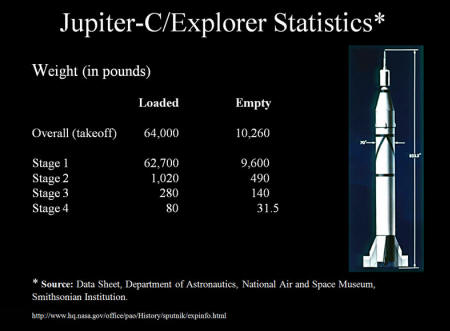
Plugging these numbers into the Rocket
Equation, and averaging the atmospheric and vacuum ISP efficiencies
of the upper stages together (as the Jupiter-C rose out of the
atmosphere that night, and the later stage ignitions became more
efficient...), gave us the maximum theoretical "by the book"
velocity those three upper stages could have imparted to Explorer I
at "orbit injection."
dV = -32.2 X 228 X
(662lb/1380lb) = 3520 feet per sec
But...
We already knew that this velocity, added to the maximum velocity
imparted by the liquid-fueled first stage (at "staging"), was the
"nominal satellite injection velocity" - what was required to place
Explorer I into its planned orbit of about "220 by 1000 miles" (red
line, below).
Since the actual orbital parameters (according to
George Ludwig's
figures) were "223 by 1592..." - almost 600 miles higher at apogee
than "nominal" (the blue line, below) - what we really needed was a
measure of how much additional velocity that approximately 600-mile
increase in apogee represented, to put Explorer I into an orbit that
much higher (and more elliptical) than originally targeted...

There's
a well-known "rule of thumb" in
rocket science - that, for "every additional foot per second of
injection velocity" at perigee (the low point of the orbit), a
spacecraft gains "about a mile of additional altitude at apogee"
(the highest orbital point).
Using this approximation, Explorer I had gained something like "an
additional ~600 feet per second"...
Was this covered by the normal variations for solid rocket
performance of that generation?
Inverting our Rocket Equation - and solving for the additional ISP
required of those solids, to match that now known additional
performance - produced the following result:
Additional required velocity = ~
600 feet per second
3520 + 600 = 4120 total feet per second for Explorer I
Increase in Explorer I injection performance = 4120/3520 =
1.17
Equivalent “improvement” in 2nd, 3rd and 4th stage
propellant ISPs = 1.17 X 228 = ~ 267 secs!
This amounted to almost a twenty percent
performance increase - in ALL the upper stage solid ISPs - over the
same solid-fueled rockets' measured performance in previous JPL
applications!
The idea that one of the 15 solids in those upper stages might
exhibit this degree of major variation, was barely plausible; that
ALL of them TOGETHER (required to produce the total delta velocity
increase) had done so that night, was simply impossible... by any
known chemistry and physics.
"Normal physics" also says you "can't get something for nothing."
Yet, somehow, by this simple calculation, Explorer I DID exactly
that...
Acquiring six hundred extra miles of "something"... from absolutely
nothing.
Just how the hell did JPL and von Braun manage to accomplish that!?

It would have been at this point - for anyone who actually DID this
simple set of calculations, in 1958 - that they HAD to have realized
they had a major discovery on their hands... and... a major problem.
The problem was:
No "small variations" - a few percent, at best - of the Jupiter-C's
individual solid rockets in the vehicle's upper stages - from "grain
size, packing density, mixture variations, etc., etc." - could
possibly account for a ~20% INCREASE in overall delta V at
burnout... resulting in almost 600 additional feet per second... and
600 additional vertical miles... of "super performance" for
America's first satellite!
So, what was left...?
That, serendipitously, Explorer I had made...
A profound and fundamental scientific
breakthrough... regarding how objects really gravitationally orbit
one another!
And that, as a result, almost 300 years
of Newton's long-accepted "Law of Universal Gravitation" was,
somehow, wrong... as might be his equally unquestioned "Three Laws
of Motion"... and potentially (shudder...), even Einstein's
"General Theory of Relativity"...
Whatever the ultimate cause - this was NOT going to be any "small"
Scientific Revolution.
And, that was precisely “the Problem”...
And the solution to "the Problem" - as we can now demonstrate - was
a political decision, made by "someone" that night, to instigate an
immediate cover-up of this entire, stunning US space discovery...
which obviously, if openly verified, would have been...
Tthe most important result of the entire space program!
A cover-up which (according to the evidence)...
Is still on-going.
For, while Ludwig and Van Allen - both eminent physicists, both
intimately familiar with the Explorer Program (because they were
designing all its intricate on-orbit measuring instruments!) -
freely published the intended orbital parameters of Explorer I we've
just cited, and even compared them to the higher, enlarged orbit...
neither of them seemed to realize (and Ludwig STILL doesn't...)
just what those numbers had to represent (unless, of course, they
were ultimately "persuaded" to remain "ignorant"...)
If either physicist, for a moment, had sat down and actually gone
through the "rocket calculations" we just have, both would have
instantly realized that to expect that type of "anomalous super
performance" - from EVERY one of the 15 solid-fueled JPL rockets
atop von Braun's modified Redstone...
Was impossible.
Yet, neither of these key physicists (nor, any other physicists,
astronomers, rocket engineers, members of the scientific press,
etc., etc.) - over these last fifty years - has apparently EVER done
this simple calculation... or stopped to consider (if they have),
even for a moment, the extraordinary alternative to the inevitable
assumption "it must have been the rockets..."
That, it might have been, instead... the Physics!
One blatantly obvious initial reason that Van Allen and Ludwig
DIDN'T do this calculation that same night, HAD to have been "Wernher
von Braun."
After all, this was "Wernher's baby!"; if HE didn't know what made
his rocket tick... what might account for its "dazzling increased
delta V"... who would?!
That von Braun was immediately prepared to be 'less than candid"
about this remarkable Jupiter-C "over performance" (initially, by
simply not discussing it...) - to, in every way, downplay the
ultimate significance of what had really happened to Explorer I that
night - is apparent in his immediate actions at the National Academy
press conference that morning...
With the entire world press corps gathered, and hanging on his every
word... he said nothing!
And, he continued to say nothing... to his death.
However, giving him the benefit of the doubt... for "great
uncertainties" in the numbers that first roller coaster morning,
when "the cold light of day dawned …" von Braun had to have found
time to do those crucial calculations. And he HAD to have realized
then that nothing involving the JPL solid upper stages could have
resulted in that amount of "extraordinary, additional
performance"...
Yet, three months later -
writing in that same Des Moines Sunday
Register article, in April 1958 - von Braun would simply say:
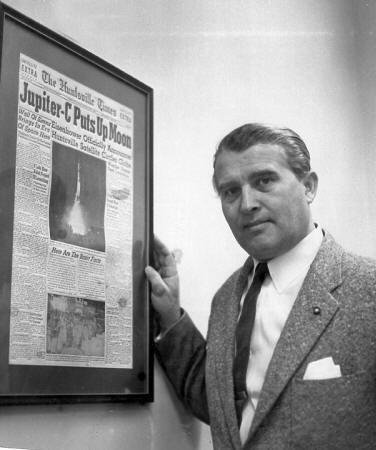
"… there’d been just a slight error
in our quick estimate of the satellite’s initial speed and
period of revolution..."
"Slight error"...
Six hundred additional feet per second
(that's just over "four hundred miles per hour..."); and... six
hundred miles higher as a direct result, at apogee...
Yet, all from... NOWHERE.
Where were the "triumphant official ABMA press releases"... the
proud "White House announcements" (at the height of the Cold War and
this sudden "space race" with the Soviets)... and then, the ultimate
"solemn ceremony" in Stockholm... celebrating such an extraordinary
scientific breakthrough in "Newton Laws" by the United States - the
first... in almost three centuries!?
The proof that von Braun knew that this wasn't just "the result of
his own rocket" - that, in fact, this was something BIG... something
potentially "extraordinary" - comes from von Braun himself:
Immediately following the baffling events surrounding the launch of
Explorer I, von Braun began quietly writing and sending out a series
of clandestine letters all over the world - to a very select group
of "extraordinary physicists"... but deliberately, NOT to any
associated with the Explorer program (like Van Allen!). In this
correspondence, he is clearly, unquestionably, looking for “an
alternative physics” - that could eventually explain what really
happened to Explorer I.
Not exactly the actions of "just a rocket guy" - complacently
satisfied with his own vehicle's performance!
One fascinating von Braun exchange involved fellow German
countryman, theorist Burkhard Heim (below).
Another - if anything, even more indicative of von Braun's real
thinking, in his persistent secret efforts to understand the
apparent “new gravitational physics” that (he obviously now believed...) had, somehow, radically altered Explorer I's orbit after launch
- involved the even more remarkable, anomalous gravitational
discoveries of a future Noble Laureate, Dr. Maurice Allais.
But first - to Heim's theoretical relevance to von Braun's
"problem"...
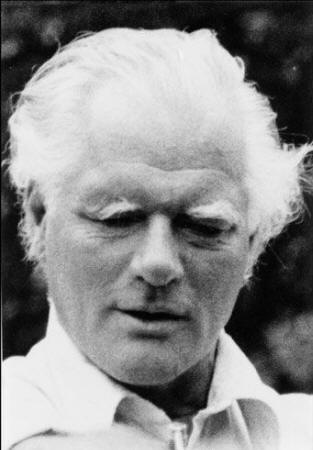
Heim (who had worked at the world-famous
"Max-Planck-Institute for Astrophysics," in Goettingen, Germany,
after the War), had rocked the physics and space communities just a
few years earlier, by presenting at the 1952 and 1954 sessions of
the "International Astronautical Federation (IAF) Congress" historic
scientific papers, outlining the first theoretical proposal for
"fuel-less field propulsion technology“ - a means of sending true
space vehicles to other planets, without the profound "limitations
of rockets"...
Because his radical proposal was backed by some extremely innovative
(if highly complex) "unified field equations," created by a bona
fide physicist attached to such a prestigious German scientific
institution, Heim immediately became something of an international
celebrity.
Here was a "scientific somebody" in the 20th century,
directly suggesting that Newton's long-inviolate Third Law of Motion
"... for every action there is an equal and opposite reaction" -
which lies at the heart of every rocket-based propulsion system -
might, in fact, be completely circumvented by a new 20th Century
"space-time field technology"...
Which could itself move through space - yet, expel NO "reaction
mass"... by electromagnetically "hooking into the very fabric of
'space-time'" itself!
Heim worked on his theories in close collaboration with quantum
theory physicist and pioneer
Pascual Jordan (himself a close
associate of Nobel Laureates, Max Born and Werner Heisenberg. Jordan
also is known as the developer of "the non-associative Jordan
Algebras").
Significantly, Heim was seeking in this collaboration to
carry out key physical experiments with Jordan... in gravitation -
because, even before the War, the latter had turned his attention
from "quantum mechanics" to "cosmology"... the origin and evolution
of the largest structures in the Universe... where gravity reigns
supreme...
But the joint projects Heim proposed, to test his own far-reaching
"gravitational theories," never materialized - as the necessary
government funding in post-War West Germany in the 1950's (except
for a small grant from the aerospace firm, Messerschmitt-Belkow-Blohm)
was apparently "not available."
The title of one of Heim's later papers (1976) - "Basic Thoughts on
a Unified Field Theory of Matter and Gravity" - specifically reveals
his fundamental and continuing interest in alternative gravity
research, some 20 years after he first burst upon the world stage...
and the obvious reason for von Braun's provocative (and
well-documented) "sudden interest in Heim" in 1958... right after
Explorer I!
For, according to the "Research Group - Heim Theory" - a collection
of international scientists currently collaborating on publishing
and discussing Heim's "unified field" work, in English (following
Heim's death, in 2001) - Wernher von Braun's telling interest -
remember, a "rocket guy" - centered specifically on Heim's radical
ideas re "...spacecraft field propulsion and orbital dynamics."
According to the
Research Group:
"...in a letter to Heim, Wernher
von Braun enquired about progress in the [German] development of
such a field propulsion system since otherwise he could not
accept responsibility for the enormous cost of the [Apollo]
moon-landing project. Heim [because of the lack of West German
government funding to develop the technology] answered in the
negative..."
From this documented correspondence, it
should be blatantly apparent that Wernher von Braun - thought by the
press and public to be merely a "steely-eyed missile man" - was
actually probing far beyond... searching avidly for an "alternate
gravitational solution" to his major Explorer I problem, one which
did NOT involve "trivial rocket explanations."
Obviously, at some point after that memorable January night, von
Braun had carried out the same calculations we just did... and had
come to the same conclusion:
Namely, that,
"Something" was radically wrong with
all existing gravitational theories... used (quite
unsuccessfully, it turned out...) to attempt to predict the
orbit of Explorer I.
In other words, Von Braun - contrary to
his public "caviler dismissals" of Explorer I's anomalous behavior
(the statements in the Sunday Register...) - privately, was
clearly... secretly... bent on finding "a serious, workable
alternative to Newton and Einstein...!"
As his independently confirmed private correspondence with Burkhard
Heim, now unquestionably confirms.
Von Braun's letters to and from Maurice Allais (below) are even more
revealing - in terms of the alternative gravitational ideas von
Braun (backed by personal experience, remember...) was obviously
willing to entertain.

Allais, a French economist by training
(he would go on to win the
Noble Prize for Economics, in 1988) was
also an accomplished physicist - publishing copious experiments
through the French Academy of Sciences [and
winning fourteen physics
prizes - including, the Gold Medal of the National Center for
Scientific Research (C.N.R.S.), the most distinguished honor in
French Science, from the 1930's through the 1980's].
The work that obviously brought Allais to von Braun's attention was
the French physicist's startling observation of "...highly
anomalous pendulum motions, made during a solar eclipse over Paris
in 1954..." (and repeated, during another solar eclipse, also over
France, in 1959).
Allais noted that the normal, progressive "Foucault motion" (due to
the rotation of the Earth) of his laboratory's uniquely-designed "paraconical
pendulum," during the eclipse, suddenly reversed... and literally
"ran backwards" (with the Earth's rotation!)... until mid-eclipse,
when the pendulum motion reversed again... rapidly resuming its
normal rate and direction of angular rotation (below)...
This set of completely inexplicable (under any current theory...)
solar eclipse observations has since been termed "the Allais
Effect."

Here (below) is a trace of Allais'
actual, remarkable 1954 pendulum observations - made during the
eclipse.
The graph shows (red line) the normal, progressive angular trend
(the downward slope) of the pendulum's apparent rotation, mirroring
the Earth's actual opposite motion.
This trend is suddenly interrupted by an upward deflection in the
graph - at the precise beginning of the eclipse (left green line) -
representative of the complete reversal (backwards rotation) of the
pendulum's (normal) forward angular motion!
This hour-long "pendulum anomaly" is then followed (near mid-eclipse
- center green line) by a rapid resumption of the normal downward
trend... once again, the normal "mirrored reflection" of the Earth's
inertial spin...

Needless to say (but, we'll say it
anyway...), this astonishing behavior was completely unpredicted ("unmodeled"
is the term...) by either Newton or Einstein - in terms of the
"normal" inertial motions of a pendulum freely swinging under
gravity...
Or, to quote Allais
directly:
"...indeed, the effects of the
eclipse are spectacular and cannot be explained in the framework
of currently accepted [gravitational or inertial] theories...
"Over many centuries, no phenomenon had ever before been
exhibited, whose observed values were from twenty to a hundred
million times greater than the values obtained by [prior
theoretical] calculation..."
In a very real sense, Allais' stunning
eclipse observations were a remarkable "ground-based version" of von
Braun's equally aberrant Explorer I behavior in space; in von
Braun's growing perception, the two phenomenon could only be caused
by the same gravitational anomaly - ergo, his obvious interest in
Allais' continuing experiments.
Documentation of this fascinating von Braun/Allais correspondence
comes from two independent sources: Professor Allais himself... and
the current, official website of the NASA-Marshall Spaceflight
Center - whose first Director was... Wernher von Braun.
Allais, writing in 1999, in "a memoir for NASA" - flatly stated:
"...with regard to the validity of
my experiments, it seems best to reproduce here the testimony of
General Paul Bergeron, ex-president of the Committee for
Scientific Activities for National Defense, in his letter of May
1959 to Werner von Braun..."
In that same year - 1999 - a summary of
Allais's provocative experiments was posted on the NASA-Marshall
website, in anticipation of a possible repetition of Allais'
original observations - to be carried out during an August, 1999
total solar eclipse about to sweep over Europe in a geometry very
similar to Allais' 1954 event.
Remarkably, the NASA-Marshall website
also cited von Braun's
"interest" in professor Allais' experiments... and even made mention
(though, quite obliquely...) of "why" he took some interest...
"...rocket pioneer, Wernher von
Braun, NASA/Marshall's first director, first became interested
in Allais' experiments in 1958, when early investigations began
to look at predicting satellite trajectories in orbital
mechanics..."
The total understatement of "the
Problem" by NASA, in 1999, and the equally apparent "downplaying" of
von Braun's much deeper personal involvement with Allais (as you
shall see...) - even after half a century - is telling...
For, the evidence of how just how seriously von Braun took Allais'
work is amply revealed by what the rocket expert publicly did next:
In 1959, following the May letter from General Bergeron (cited by
Allais, above) - von Braun apparently personally arranged for the
French physicist to publish a lengthy, three-part series on his
revolutionary pendulum experiments
in a leading US aerospace journal
(and, for the first time in English - as Allias' published
experiments had previously been available only in French...):
The journal was "Aero/Space Engineering" (below).

Allais' series did not "beat around the
bush," but directly confronted the startling possibility that his
lengthy series of meticulous pendulum observations, consisting of
literally thousands of hours of detailed repetitions - which
included the extraordinary, totally unexpected 2 hours and 34
minutes of the amazing events during the '54 eclipse - revealed
fatal flaws in the previously "sacrosanct" laws of Newton and
Einstein...
The same "fatal flaws" first experienced by von Braun, in space...
in the bizarre orbital behavior of Explorer I, the night of January
31, 1958.
In hindsight, von Braun seems to have hoped that, by sponsoring open
US publication of Allais' revolutionary data in a major US space
engineering publication, the resulting "discussion and debate" might
spur a timely "innovative engineering solution"... one that he
himself could ultimately then use to quietly solve "the secret
Explorer problem"
For, there was still no open acknowledgment of the existence of the
"Explorer anomaly" itself... either, within the aerospace community,
or to the public. Von Braun's idea may have been that, by exposing
other rocket engineers and scientists to Allais' astonishing,
compelling experimental contradictions to existing gravitational
theory... someone in that community "might just hit on a
solution"...
At least, that's the best I can come up with at the moment, to
explain - from a remove of over 50 years - von Braun's clearly
contradictory efforts in this time period - his continuing decision
(agreement?) to hide the "ultimate space discovery" from the rest of
the world... but, simultaneously, to sponsor open publication and
discussion of the potentially revolutionary physics that seemed to
lie at the root of "the Explorer problem!"
For... "the Problem" was only getting worse.
In the slightly more than a year and a half that had elapsed -
between the first appearance of the "Explorer anomaly," January 31,
1958, and the US publication of the first section of Allais' unique,
three-part experimental examination of the real nature of gravity,
in September, 1959 - von Braun had successfully orbited two
additional Explorer satellites... and the US Navy had orbited three
(of its planned eleven...) Vanguards.
And, all of them... exhibited the same type of "baffling orbital
anomalies" as Explorer I!
Von Braun's "worst fears" - that Explorer I was NOT a fluke - were
totally confirmed less than two months later... with the successful
orbiting of Explorer III.
Launched March 26, 1958, the satellite was planned for a trajectory
essentially identical to Explorer I's original intended orbit: 220
by 1000 miles. However, to the chagrin of von Braun and his launch
team, the new spacecraft also wound up in a close repeat of Explorer
I's peculiarly extended flight path!
And, again, no one (except von Braun...) seemed to have a clue as
to what was really going on...

Explorer III 's final orbital parameters
were - "125 miles by 1750 miles... with a period of 115.7 minutes" -
an orbit more elliptical (and even higher) than Explorer I's... but
of almost exactly the same duration!
There was NO WAY this could be dismissed as simply another "over
performance" by the Jupiter-C (and yet, of course, according to the
"experts," that's all it could be...)!
With the
launch of Explorer IV four months after that - July 26,
1958 - "the anomaly" was solid:
Explorer IV's final orbit was "163
miles by 1373 miles..." compared to the, again, intended "220
by 1000." At first glance, this does NOT look like any kind of
confirmation... until the fact that Explorer IV was carrying
twice the payload of scientific instruments, compared to the
previous spacecraft, was factored in...
Then, the "peculiar physics" matched
once again - perfectly.
As previously noted, in this same time frame - March 17, 1958 to
September 12, 1959 - the US Navy (finally) succeeded in placing
three Vanguard satellites of its own in space.
All of them... also reached "higher and more elliptical orbits" than
originally planned - so high and so elliptical, that they now
represent the three oldest man-made objects still orbiting the
Earth... half a century after they were sent aloft; each still with
a remaining life span (before they someday, finally, dip low enough
to reenter the Earth’s atmosphere...) of "several hundred years"...
And yet, despite all this... "the secret" held.
No one in the press, writing about any of these historic early
launches, even seemed to suspect that "something was seriously
wrong" (or, if they did, they certainly didn't write about it...).
They didn't seem to even notice that all these early orbits were
"significantly higher" than originally planned, at altitudes (as
anyone can calculate...) the rockets themselves weren't even
capable of reaching!
But, since von Braun - the hero of the hour - was saying nothing...
it had to be "the rockets," right? They were simply "more efficient"
than originally designed (rah... rah for "good ol' American
technology." Take that, you commies...).
After all, who wanted to argue with "the man?!"

Von Braun's cover-up - and
simultaneously quiet (if not quietly desperate) quest... for an
"alternative physics" to ultimately fix the problem... was
working...
Certainly, "the cover-up" part....
At this point, if there are still skeptics remaining out there
(there always are...) - who simply don't (or won't) believe us -
look carefully at von Braun!
Clearly, von Braun's aggressive world-wide search for a workable
physics "work around" to this major (if carefully hidden...)
overarching problem, was not something he was doing "just out of
idle curiosity"; he, of all people, obviously realized that if this
apparent "breakdown" of Newtonian mechanics in satellite dynamics
was not ultimately understood - and then somehow controlled - the
impossibility of placing future satellites in any kind of planned
orbits would rapidly spell "the End" to the entire space program!
If spacecraft couldn't be launched on precisely predictable
trajectories, then, scientific missions based on known satellite
orbits (and thus, calculable Earth geometries), couldn't be
successfully carried out.
Carefully designed military reconnaissance
fly-overs of intended targets (like, suspected missile bases in the
Soviet Union...) couldn't be pre-planned (a Cold War concept that
the Pentagon was secretly counting on, even then...) and missions
- unmanned or manned - to the Moon... or to the other planets (such
as Mars - von Braun's personal favorite...)
Forget it!

So, it was imperative that someone - von
Braun! - truly "figure it out"... and soon.
For mission planners, on both sides of the Iron Curtain (after the
successful launch of Explorer I), had decided to raise the stakes...
and set their eyes on the Moon as the next prize in this new
geopolitical game.
William Pickering, Director of the Jet Propulsion Laboratory (JPL) -
which, you might remember, had designed both Explorer I and its
three solid-fueled upper rocket stages - was at the forefront of
those planners on the US side who now had their sights set on places
"far beyond low-Earth orbit...”; Pickering, in the immediate
aftermath of Sputnik,
had strenuously argued for a major US effort
to “…send an American spacecraft to the Moon at the earliest
possible opportunity..."
In the Pentagon, just one month after Explorer I was launched, ARPA
(the "Advanced Research Projects Agency") was hurriedly formed by
President Eisenhower, as a means of coordinating the various
military services response to the new Soviet space challenge (two
years later, the new civilian space agency, NASA - also formed by
Eisenhower in the summer of '58 - would assume control of all of
ARPA's "non-military" space missions).
Within a month of this "military R&D agency's" formation, taking its
lead directly from Pickering's earlier proposal ARPA dramatically
announced - on March 27, 1958 (just one day after von Braun
successfully orbited Explorer III) - that it was looking to "shoot
the Moon," with a "quick and dirty" program called "Pioneer"... as a
way of finally upstaging the Russians and taking back "some of the
political momentum" in the "space race."
That was the obvious political intent.
In the actual DOD statement, the more diplomatic language read,
"...to determine our capability of exploring space in the vicinity of
the moon and to obtain useful data concerning the moon."
Unfortunately, from August 1958 through December of that year, there
were four straight failures in this hurriedly-put-together, first
US "Lunar Program."
And then, one day after New Year's Day, January 1959... came another
Soviet surprise:
"The First Soviet Cosmic Rocket"
(later renamed Luna-I...) was launched by the Soviets toward
the Moon , on an upgraded "R-7 intercontinental rocket" -
placing an ~800-pound unmanned Russian probe on an impact
trajectory designed, for the first time, to contact the surface
of another world...
Given the size of the Soviet "Block-E" upper stage atop its R-7
launcher (below - top), compared to the tiny American Pioneer
lunar spacecraft (below - bottom), and Block E's sheer mass
(which provided ample ability to carry both the required
guidance system and the fuel for several mid-course corrections
en route to the Moon...), Luna I should have easily impacted
"within 60 to 120 miles of its intended aiming point..."
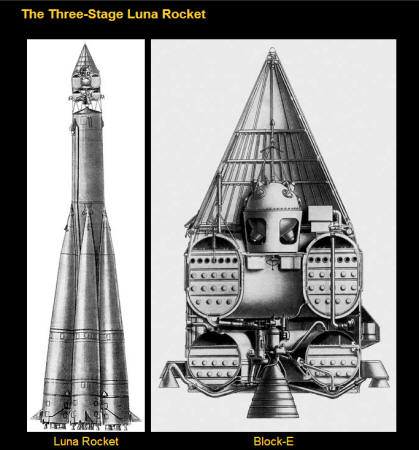

Instead...
Thirty four hours after launch, the Soviet's first unmanned lunar
probe successfully crossed the Moon's orbit... but, ahead of the
Moon... by some "3700 miles..." (below), before eventually moving
into a ~ year-long, recurring solar orbit: the first manmade object
of the "space age" to totally escape from Earth... renamed "Mechta"
- Dream.

Major question: why, with all that mass
and technology going for them... did the Russians miss!
Von Braun, looking at their mission from the outside (since, it was
damn certain the Soviet's weren't calling him with daily updates!),
could only logically conclude one thing:
That, whatever "non-Newtonian" forces were acting on his (and the
Navy's Vanguard) spacecraft in Earth orbit, seemed now also to be
acting on the Soviets as well! This was the first independent
confirmation of this possibility, as in Earth orbit the Soviets
could claim (and had) that any orbit they achieved was the one that
"they'd intended"...
Missing the Moon... by more than its own diameter (2160 miles)...
and,
with the Soviet's sophisticated space navigation technology,
was pretty dramatic evidence that the mysterious "Force"
(non-Newtonian gravity) demonstrably operating on von Braun's
spacecraft... had also been operating on the Soviet's, all along!
And... that it extended into space at least to the distance of the
Moon...
What was also obvious was the fact that, they too, seemed totally
incapable of doing anything about it!
Unfortunately, this crucial insight still didn't provide von Braun
with any practical assistance in compensating for these maddening
"non-Newtonian" celestial mechanics in his own program...
For, two months later, when it came von Braun's turn to try again -
with another US Moon-bound mission (like Explorer I, built by JPL),
"Pioneer 4" - the JPL/von Braun spacecraft missed the Moon by 37,000
miles (below)... ten times the Russian's error!

Pioneer 4 Trajectory
And still, the US press suspected
nothing.
"Space travel" in these early, heady days, was still so new, so
filled with all sorts of "known unknowns" (to borrow a notorious
line from later Secretary of Defense, Donald Rumsfeld...) that the
press covering these early missions was essentially "just reading
press releases."
They were certainly NOT doing any original,
sustentative reporting on... let alone real, in-depth, original
investigations of, "government space institutions"...
If the US Army, the Navy, ARPA... eventually, NASA itself... were
all excusing these early mission failures and anomalies as just
typical "equipment problems," or, "unexpected thrust," or, "guidance
difficulties," etc., etc. - who in the press corps, in those early
years, knew enough about this totally new profession - literally,
"rocket science!" - to effectively argue with a "giant" like von
Braun?!
And - who would want to try!?
So, the cover-up rolled on...
Ten months later, Von Braun had to have experienced another major
shock when, on September 12, 1959, the Soviets launched their second
unmanned "Cosmic Rocket" to the Moon...

And this time... they didn't miss.
What had the Soviets learned in those "intervening months," that von
Braun was still attempting to figure out - regarding the
"non-Newtonian" forces now demonstrably acting on all spacecraft -
whether they were in low Earth orbit... or, headed for the Moon!?
And, how had they been able to "figure it out" - allowing their
second lunar attempt to successfully crash land on the lunar surface
(complete with Soviet flag and Communist Party pennants)... once
again, ahead of the Americans?
Inquiring minds...
And yet, just nine years later... on December 24, 1968... three
American Apollo astronauts - with almost surgical precision - would
be successfully inserted into lunar orbit via Earth-based,
computer-driven orbital calculations... carried out "in Houston."
They would make ten historic circuits of the Moon that Christmas
Eve... returning live television from their lunar orbit to an
awe-inspired world... complete with an eerie and unique reading of
Genesis... before "returning safely to the Earth" - exactly as John
Kennedy envisioned...

How did NASA do it?!
How - in the face of the baffling "non-Newtonian gravitational
anomaly" discovered by von Braun only ten years earlier, which had
made it impossible for the US to not only predict future orbits of
Earth satellites, but also to successfully aim any spacecraft at the
Moon... and certainly, to successfully place one in lunar orbit -
did the United States actually carry out... just nine years after
the Russians hit the Moon with Luna 2...,
Apollo 8?!
More inquiring minds really want to know...
Just eight years earlier... in 1960... von Braun was made head of
NASA's massive rocket development program, to ultimately design the
monster "moon rocket" - the 363-foot tall, 3300-ton Saturn 5 (above
and below) - that would one day send Americans triumphantly to the
surface of
the Moon...

In addition...
Von Braun was one of the key NASA personnel - as first Director of
NASA's "Marshall Space Flight Center" - tasked with finding the best
way to use this massive vehicle he was designing "to carry out the
mission"... even before Kennedy's historic commitment to "Apollo,"
in 1961.
Yet, back in 1960, von Braun secretly also knew he couldn't really
"complete that mission"... because of the continuing "non-Newtonian
dynamics" problem!
The immediate task at hand for the rest of NASA (which didn't know
they had a problem...) was determining exactly "how" such a massive
launch vehicle could best be utilized in the envisioned "Apollo
Program",
-
in support of a "direct ascent" mode (go from Earth, land
directly on the Moon, then return)
-
in an "Earth orbit rendezvous"
mode (rendezvous various elements of the Apollo Expedition in Earth
orbit first, before heading for the Moon and then returning)
-
in
a "lunar orbit rendezvous" mode (send two Apollo craft - on one
rocket - to the Moon... splitting them apart in lunar orbit for a
separate landing by one of them, before rendezvousing back in lunar
orbit with the first... and then returning safely to the Earth -
below)
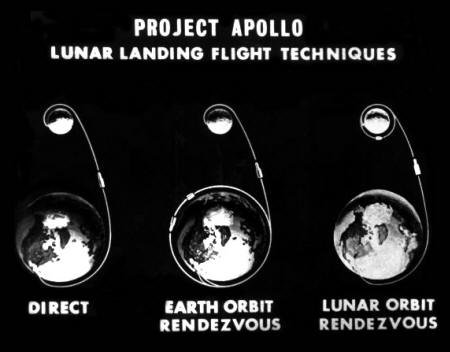
The last concept was nicknamed "LOR"...
vigorously championed by a young engineer from NASA-Langley, John Houbolt .
But, despite LOR's clear engineering and economic
advantages in making it feasible to reach the Moon before the
President's 10-year deadline (by NOT attempting to build and land a
spacecraft on the Moon weighing close to a hundred tons, and
standing almost 70 feet high - below!), Houbolt kept running into
"...mysterious brick walls" - in his years-long, virtually "one man
crusade" to convince NASA senior management that this was the ONLY
way that Apollo could succeed.

Houbolt found, to his puzzlement and
increasing professional frustration that, despite making "eminent
engineering sense to more and more NASA managers and engineers..."
(when he got a chance to brief them on the full details in person...), LOR stubbornly remained "for some reason" (that no one would
ever come right out and tell him...)
the least favored of all of
these early lunar landing ideas... across the Agency.
Based on what we have documented here, at least one man in NASA knew
that "reason"....
Von Braun, obviously (because of the still-concealed "non-Newtonian
dynamics" situation...) was adamant that the only hope of achieving
any Apollo Landing was "direct ascent."
That meant that your intended "rendezvous target" was the entire
Moon... as opposed to (in LOR) "an infinitesimal, artificial
spacecraft... floating somewhere in the dark... in lunar orbit."
This conviction was, undoubtedly, based on von Braun's assessment
that, if the Russians had (somehow!) made it to the lunar surface
with a direct ascent trajectory for their unmanned Luna-2... he
could too!
With "direct ascent," with "a big enough rocket and enough fuel..."
you could employ a "brute force technique" to get to the surface of
the Moon - overwhelming the unpredictable orbital dynamics of
whatever gravitational anomalies were interfering with the
spacecraft trajectories enroute... by using repeated rocket burns
(and a lot of fuel...) to constantly correct your course... until
you safely landed on the Moon!
But that required a truly massive rocket... much bigger even than
the Saturn 5...
This, in our opinion, is why von Braun was so fixated on "direct
ascent" from the beginning:
a single, ultra-massive rocket (that he
eventually, fittingly called Nova - see below) - designed to send an
equally massive lunar landing craft directly to the lunar surface
from the Earth... carrying sufficient fuel to ultimately counteract
any "non-Newtonian uncertainties" that it encountered on the way
there... and... in returning home.

It was the only Apollo strategy - based
on what von Braun knew about the real orbital dynamics of cis-lunar
space in 1960 - which had even a slim chance of actually working!
Later, because of the sheer size of the Nova fuel margins, von Braun
reluctantly expanded his "direct ascent" lunar mission concept to
include "Earth Orbit Rendezvous" (EOR); the "brute force" method
would also work in Earth orbit - ultimately allowing two (or more)
spacecraft to come together - rendezvous - and thus, a greater
mission flexibility in assembling the right spacecraft components
for Apollo... before heading for the Moon.
And, if anything went wrong - if rendezvous was NOT achievable
(because of the continuing "non-Newtionian dynamics problem...") -
the astronauts, with EOR, were still "only a couple hundred miles
above the Earth"... where, within hours, they could easily come
home...
NOT possible with LOR... where the astronauts could become literally "stranded"... in a
spacecraft not capable of carrying enough fuel to overcome the even
more uncertain "non-Newtonian forces" - operating 240,000 miles from
Earth... in lunar orbit.
This, from our analysis, was von Braun's real (though never stated...) reason for totally rejecting LOR... until, that is, the summer
of 1962...
Then - to the amazement of the entire aerospace community, including
(especially!) his own Marshall engineering team (who were definitely
NOT for LOR) - von Braun abruptly reversed his previous position on
"how best to accomplish Kennedy's grand vision," and announced at a
major June, 1962 NASA meeting, that he had "changed his mind," and
was now "backing lunar orbit rendezvous unconditionally..."
This was von Braun's
public explanation:
"...we at the Marshall Space Flight
Center readily admit that when first exposed to the proposal of
the Lunar Orbit Rendezvous Mode we were a bit skeptical -
particularly of the aspect of having the astronauts execute a
complicated rendezvous maneuver at a distance of 240,000 miles
from the earth where any rescue possibility appeared remote.
In
the meantime, however, we have spent a great deal of time and
effort studying the four modes [Earth-orbit rendezvous, LOR, and
two Direct Ascent modes, one involving the Nova and the other a
Saturn C-5], and we have come to the conclusion that this
particular disadvantage [low probability of successful astronaut
rescue in lunar orbit] is far outweighed by [LOR's]
advantages..."
Von Braun's sudden, simply inexplicable
(to most NASA veterans...) high profile "LOR reversal"... could
only mean one thing:
That - in this crucial time frame - "something" suddenly had
changed... in the whole (still classified) "non-Newtonian dynamics"
situation!
Curiously, just over a month before this major NASA meeting, on
April 26, 1962 - out of all the previous failed attempts - a US
unmanned spacecraft, Ranger 4, finally, successfully,
impacted the
surface of the Moon!
Was von Braun's sudden, dramatic "turn around decision" regarding
LOR because, the "non-Newtonian dynamics problem" - still standing
firmly in the way of all reliable space rendezvous - had finally,
quietly, been solved? Had Ranger 4 been merely the final, visible
demonstration of this in-space celestial-mechanics resolution (with
the publicly-presented aspects of the mission merely a convenient
“cover”)?!
The more I thought about it (and my own recollections from the early
60's, of the extremely troubled history of the entire "Ranger
Program" from this period - where, successive spacecraft in the
series "just kept failing," and there were even eruptions in
Congress over "gross NASA mismanagement" of the laboratory in
charge, coming after two equally-scathing "high-level" NASA
Headquarters reviews of JPL's Ranger management performance) - the
more I began to wonder...
Could the entire Ranger Program have been just a "cover," all
along... a test-bed (complete with "scientific instruments" and even
"principal investigators" from various universities...), but for
the real purpose of flying - in space - various deep space mission
profiles... in repeated empirical attempts to understand, and then
ultimately fix, "the Problem?"
Was this the real objective of Ranger from its inception: to develop
practical "non-Newtonian, celestial-mechanics equations"... that
could successfully correct for the "non-Newtonian anomaly"... in
future NASA missions?!
Was this how NASA learned - literally by "trial and error" (LOTS of
error...) - how to so precisely navigate spacecraft in Earth orbit
and deep space... despite the continuing "non-Newtonian Problem?!"

Like a flash bulb going off, I suddenly
realized that this specific NASA laboratory, once even under
Congressional investigation for all the "gross irregularities"
discovered in the Ranger Program, which had designed... and built...
and launched Ranger 4 - the first unmanned NASA spacecraft to
finally, navigationally, make it to the surface of another planet -
was none other than the same laboratory (even before it was in NASA...) whose engineers had also designed and built... Explorer I...,
Bill Pickering's... Jet Propulsion Laboratory!
And suddenly, it all fit...
There was even a statement
in an official NASA history of the Ranger
Program that correlated exactly with our own assessment:
“…as the [Ranger] project got
underway, the [supposedly scientific] priorities established at
JPL revealed the essential purpose of all five Ranger flights to
be the development of 'basic elements of spacecraft technology
required for lunar and planetary missions' [emphasis added]..."
Which would have definitely included “…develop viable interplanetary navigation techniques...”
JPL had to have known about the "Explorer I anomaly" - and, from the
beginning!; it had to have been aggressively working on its own
solution (with von Braun?)... since that January night, in 1958!
Who would have had better motivation to figure out and solve this
overwhelming celestial navigation problem - than the one laboratory
whose director was intending from the beginning (according to
Bill
Pickering's official NASA biography...),
"to turn JPL into NASA's
most important interplanetary laboratory..."?

Which (by solving this "insolvable
problem?" - and learning to control a Physics which makes completely
obsolete both Newton and Einstein!)... it ultimately became!?
Suddenly, the much broader policy implications of NASA's consistent
"kid gloves treatment" of JPL - even during the Ranger fiasco -
especially, in terms of the "inexplicable influence" JPL has seemed
(somehow) to exert over NASA's other programs (out of all proportion
to its inherent size and actual institutional role...) took on
entirely new meanings...
In this scenario... without JPL, and its (obviously top-secret)
successfully-developed (via Ranger...?) interplanetary space
navigation computer programs, no one else in NASA was going anywhere… unless JPL agreed.
And that could explain almost everything… regarding NASA’s
50-year-old history... and actions.
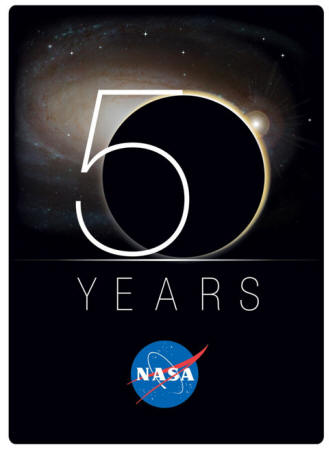
In terms of Apollo, the crucial
"last-minute switch" by von Braun - from opposing to supporting LOR
- was clearly the single, key decision that ultimately allowed the
entire Apollo Lunar Program to succeed.
Because, with NASA's
official selection of LOR a few weeks later, as
the means of actually landing on the Moon - a separate, smaller
spacecraft to take the astronauts down from lunar orbit to the
surface... and back up again - the entire Apollo Program suddenly
became "manageable": the individual Apollo components became far
"lighter" (less massive...)
Thus, they now required (comparatively
speaking) a much smaller moon rocket to carry them ["only" the
Saturn 5 - as opposed to von Braun's vastly more robust (and far
more expensive!) twelve million pound thrust Nova rocket].
Ultimately, because of all of this, the Apollo Program itself was
carried out on a much shorter developmental time-frame than it would
have followed otherwise - which, in the end, was what enabled NASA
not only to beat President Kennedy's visionary deadline... but, to
"beat the Russians to the Moon" while doing it!
Did Wernher von Braun - with "a little help from his friends at JPL"
- make all this happen, by finally "figuring out" Explorer I's
extraordinary, still-classified, "non-Newtonian discovery... and
problem"... and, in 1962?
And, if so, how did they do it... and in so doing, potentially give
Humanity the keys to unlocking not only the entire solar system to
future human exploration...
But, the secret of building real "anti-gravity spaceships" - with
which to ultimately colonize that solar system!
Finally.
A full half century after Explorer I... is "someone" now
doing exactly what we've just described:
Carrying out a real, "top-secret"
Space Program... perhaps, by now, far beyond this solar
system... and, with a fleet of "gravity-controlling
spacecraft"... all based on JPL's "secretly-derived New
Physics"... while the NASA that we see on television... still
pretends "it only plays with rockets?!"
And, no one in the American press corps
is still suspecting... anything!?

Part II
In Part I above, we described surprising - and
apparently totally unrecognized, until now - pivotal new details
around the seminal events which quietly unfolded the night of
January 31, 1958 - when the United States finally carried out its
first successful launch of an artificial Earth satellite, Explorer
I.
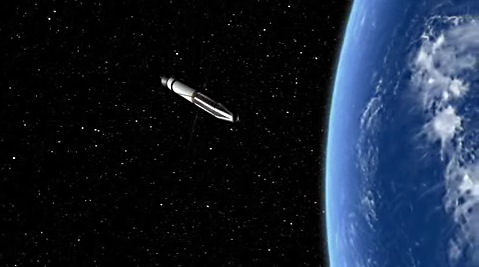
How, Wernher von Braun - "Operation
Paperclip" chief German rocket engineer, and head of the US Army
effort that actually launched Explorer I (using the Jupiter-C rocket
that von Braun and his German team had specifically designed) - was,
at first, intensely disappointed... then, obviously surprised and
overjoyed... and finally, completely baffled...
By the totally unexpected orbital performance of "his" first US
satellite.
For - mysteriously - Explorer I had reached an orbit of the Earth
that night fully one third higher than the one (green line - below)
originally planned!
We also noted in Part I of this report the immediate - and still
continuing - national security classification of these amazing
scientific findings, which have both prevented open civilian
research into the far-reaching implications of Explorer I's
astonishing "anti-gravity" behavior for these past fifty years... as
well as any application of those findings to desperately-needed
energy or transportation problems here on Earth.
Yet, despite this "security lid,"
we were able to document von
Braun's surprising, clandestine, years-long personal search -
following Explorer I - for "answers" to these inexplicable
celestial-mechanics questions... which eventually set him on a
remarkable one-man quest for "an entire alternative physics" - which
could explain America's first satellite achieving an orbit (yellow
line - below) for which von Braun's own rocket was literally
incapable of reaching... on its own.

But, even more remarkable... Explorer I
was not alone in this achievement!
Review of the
publicly-available data revealed the
equally-unexpected "over performance" of two
additional Explorer
satellites in von Braun's early Army program, as well as similar
"mysteriously enlarged orbits" of all three successful US Navy
Vanguard satellites... to the point where the latter have now become
the oldest man-made artifacts still orbiting the Earth!
And yet, as also noted in our first section - even after fifty years
- no one seems to have noticed or asked any in-depth questions about
this astonishing sequence of events:
the repeated, gross violations
of both "Newton's Laws" and "Einstein's Relativity"... in the
launching of America's first satellites!
To say nothing of the simultaneous appearance of enormous quantities
of literal "free energy"... in each of their much larger orbits...
All... apparently from nowhere!
In this Part 2 of our continuing investigation into von Braun's
amazing "secret" - we will now lay out, based on our own ~ 20 years
of "hyperdimensional research and experimentation," just how we
"figured it out"; how we have been able to "back engineer" what von
Braun (and JPL...) themselves eventually had to have deciphered
about this startling phenomenon, and what it could mean even beyond
"a fundamental revolution in celestial mechanics..."
Explorer I's radically "non-Newtonian" orbital behavior (and that of
the other US satellites'...) must rank as THE major scientific and
political discovery of the early space program... if not the last
fifty years of solar system exploration!
Regardless of the public secrecy and security classifications that
high-level governmental policy makers immediately placed around this
night, the question which MUST be asked now is:
"were von Braun (and
his associates at JPL) eventually able to turn this revolutionary
scientific discovery... into a workable technology?
A technology which ultimately could control even... gravity itself?!
And if so, has this overwhelmingly important technical and political
development also been officially kept secret, literally for
decades... from both the American taxpayer... and the world?"
As noted earlier, our own ~ 25 years of research may have given us a
technical advantage that von Braun (at least, initially...) did not
possess: a working scientific theory (the
Hyperdimensional Model) -
which, from the beginning, has predicted distinct "non-Newtonian"
spacecraft motions and behavior...
There is, however, another school of thought vis a vis "what did von
Braun (and other Operation Paperclip Germans) really know about
Explorer I's 'non-Newtonian dynamics' ..?" - an historical
perspective extensively documented and discussed in the works of our
friend and colleague, Dr.
Joseph Farrell:

In this discussion, there was the
definite possibility that von Braun (after all, once a Major in
Himmler's "SS"...), in fact, was privy (along with other key
members of his own "Operation Paperclip" imported German team...)
to a major, ultra-secret, Nazi black-ops SS research and development
program - termed "the Nazi Bell Experiment" (above and below).
An
extraordinary experiment which (according to officially declassified
"intel" documents from Eastern Europe, made available after the
reunification of Germany...) "manifested several, extremely
anomalous phenomenon... ", including...
Anti-gravity!
Which would have been, of course, directly relevant to Von Braun's
own ability to instantly recognize the similar "non-Newtonian
behavior" of Explorer I!

After looking at this really hard, I
happen not to share this point of view... and neither, by the way,
does Dr. Farrell.
If von Braun had been knowledgeable about prior "... Nazi inertia
and gravity-control experiments" ala "the Bell," why did he then
personally go "in hot pursuit" of an alternative physics theory to
explain "the inexplicable" around Explorer I?; in other words, why
was he so obviously surprised...!?
Why, as part of his major effort to understand the startling
phenomenon that accompanied Explorer I's launch into orbit, did he
subsequently write to all those "alternative physicists" around the
world, seeking a new theoretical "non-Newtonian solution" to "the
Problem?"
Why not simply, quietly, consult with more knowledgeable members of
his own German team... in terms of details of the Bell Experiment he
might not have personally known?
In fact, von Braun's well-documented, "inquisitive behavior" - after
the "shock" of Explorer I - compellingly argues for a distinct lack
of knowledge of the "Nazi Bell" on his part... and certainly, a
total ignorance of the radical, alternative physics that the Bell
manifested to those directly interacting with its technology... to
the point of actually killing some of the scientists and technicians
involved during the SS-run experiments!
However, there is one other possibility..., that von Braun might have heard "just enough" about the Bell (from
"someone" that he trusted...) to impel him - after his Explorer I
experience - to seek further information... to find independent,
contemporary confirmation of the existence of such a "radical,
alternative physics"... on his own.
Whatever the facts around his "curious interest" in such physics
(and we may never know, for sure...), unlike von Braun, we at
Enterprise, as previously noted, had the distinct advantage of a
remarkable, redundant, beautifully convergent series of
non-classified "anomalous gravity and inertia experiments" to start
out with - when we began seriously to examine "the Explorer
problem."
In addition, also unlike von Braun (if you totally discount the "he
knew about the Bell" scenario...), we had the distinct advantage of
a set of precise theoretical predictions from our "Hyperdimensional
Model" to go on...
All of which formed an extremely solid foundation from which
Enterprise could attempt to "back engineer" the ultimate process von
Braun and JPL must have used in their years-long, documentable
efforts to "figure out the Problem."
It is at this point that we must introduce another remarkable player
in this "drama" - the late "alternative physicist," Dr.
Bruce DePalma (below).

DePalma (whose brother is the well-known
Hollywood director, Brian DePalma) started his career by graduating
from MIT the very year von Braun put Explorer I in orbit - 1958. In
graduate school, he pursued electrical engineering - both at MIT and
Harvard.
After grad school, DePalma went to work for some of the Nation's
most prestigious scientists and scientific institutions - serving as
Lecturer at MIT under Herold Edgerton; and Head of Photographic R&D
for Dr. Edwin Land - at the famed Polaroid Corporation.
But after almost 20 years of watching the American Science
Establishment "up close" - as it repeatedly ignored new experimental
evidence in favor of traditional theoretical "explanations" -
DePalma one day got fed up, and decided to resign... to create his
own independent research organization - which he called "The
Simularity Institute."
Based in part on his extensive lab experience with rotating
electrical equipment (motors, generators, etc.), DePalma initially
became fascinated by the electrical and inertial properties of
"magnetized gyroscopes..."; after leaving MIT and extending this to
gyroscope dynamics in general, he investigated a wide-ranging series
of "systems in rotation"..., which is how our totally independent research paths eventually
crossed.
In 1989, as Erol Torun and I were just beginning to grapple with
some of the higher-level implications of our brand-new "Hyperdimensional
(HD) Physics Model," paraphrasing the old joke about "the most
important things to remember about business real estate..."
I
paraphrased a (somewhat flip...) response to a similar question
about our work...
"What are the three most important
things to remember about 'Hyperdimensional Physics?';
rotation... rotation... rotation..."
Later, when I went looking for a serious
"alternative physicist" (meaning, someone who was open to the
"unexpected"...) to run some of our HD ideas past, a major figure
in the "free energy" community, Don Reed, strongly recommended that
I talk to "Bruce DePalma."
It was probably one of the most important recommendations I've ever
received...
Because...
As noted above, DePalma - since the 1970's - had been carrying out
perhaps the most exhaustive laboratory studies of "bodies in
rotation" - including MASSIVE objects (~ 30 pounds...), spinning at
very high velocities (~ 7600 revolutions per minute...) - that I
had ever seen (below).
He had, thereby, accumulated an extensive
experimental database on a subject not normally dealt with in
mainstream physics or mechanics:
Rotation.

Matching our theoretical predictions of
"the HD Model" against Bruce's extensive experimental lab results in
rotation, became one of the true joys of our initial professional
collaboration.
For instance, early on Bruce introduced me to the simplest - yet,
probably, the most profound - of all his many rotational
experiments. He just called it (fittingly...) "the spinning ball."
Conceptually, the experiment could not have been much cheaper, or
easier to carry out:
Two 1-inch steel balls (like those found in every pinball machine in
America...) were positioned at the business end of an ordinary
power drill; one ball was in a cup attached to the drill's motor
shaft, so it spun - at a very high rate of speed; the other ball was
in an identical cup, attached by a bracket to the stationary drill
casing, adjusted so that it was level with the first ball.
The experiment consisted of positioning the drill vertically, cups
"up," and pressing the drill switch on the motor.
The drill motor (and its associated cup, containing one of the steel
balls) rapidly spun up to approximately 27,000 RPM. The cup attached
to the side of the drill (with the second steel ball inside it...)
was not rotating...
When the drill motor had attained its maximum speed, DePalma (or,
more often, Ed Delvers, his assistant...) would shove the drill
into the air with a fast, upward motion - suddenly stopping the
drill it in mid-flight. This would, of course, cause both 1-inch pinballs to fly out of their retaining cups in the same upward
direction - the "spinning ball" (hence the name...) and the
non-spinning ball, right beside it.
DePalma, from his years spent working with Dr.
Herald Edgerton at
MIT - the famed inventor of "stroboscopic photography" - was an
expert in such stop-motion photography as well.
By positioning
Delvers against a gridded black background, in a darkened laboratory
(below), and then illuminating the two upward-flying steel balls
with a powerful strobe light, DePalma was able to take time-exposure
photographs with the camera's shutter open, the "pin-balls" only
illuminated (at 60 times per second) by the strobe's periodic
flash...
The result was a striking "stroboscopic, time-lapse photograph" of
the parabolic arc of both steel balls - flying upward and then
downward under Earth's gravitational acceleration (below).
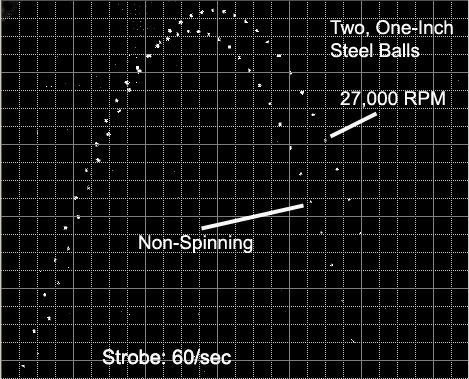
Looked at even casually, one can
instantly see in the resulting time-lapse image (above) that the two
pin-balls did NOT fly along identical parabolic arcs (as they should
have); unmistakably, the steel ball that was rotating (at ~27,000
rpm) flew higher... and fell faster... than the companion ball that
was not rotating!
An experimental result in direct violation of everything physicists
have thought they've known about both Newton's Laws and Einstein's
Relativity... for almost (in the case of Newton...) three full
centuries!
The above ~ 34-year-old image is a recent scan of one of the
original "spinning ball photographs" from DePalma's own ~30-year-old
files, contrast-adjusted in PhotoShop (with text and grid added), to
bring out the data in the faded original. Nothing else has been
added or altered.
What this photograph reveals is truly remarkable... for, in direct
violation of both Newton and Einstein, it SHOUTS that "inertial
mass" and "gravitational mass" are NOT equivalent...,
thus violating the foundation of all modern physics in one elegantly
simple experiment - which anyone can safely repeat... even at home!!
When I first saw the orbit of Explorer I (below, right - outer blue
line) - compared to the intended orbit (below, right - inner red
line) - my thoughts instantly flashed to the DePalma's remarkable
(and highly controversial) "spinning ball experiment" (below -
left)...
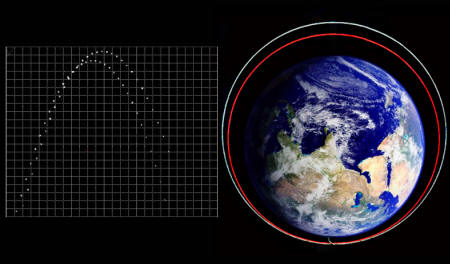
The physics of each was identical - a
"mass" thrust vertically against the pull of Earth's gravity by an
"outside" force.
In Depalma's case, literally the hand of the
experimenter - throwing the two pin-balls simultaneously into the air
at the same speed; in the Explorer I example, von Braun's Jupiter-C
rocket supplying the "outside force" - accelerating the satellite
into a trajectory fast enough and high enough to eventually "fall
around the Earth" without hitting it... the quintessential
definition of a satellite orbit.
Was it possible that von Braun had - inadvertently... somehow
duplicated some aspect of Depalma's elegantly simple "spinning ball
experiment" that night in January, 1958... some ~ 20 years before
DePalma would, in fact, carry it out?!
Was THAT why Explorer I had been boosted so much higher than
originally planned that night...?
Could it be as simple as... that!?
Of course, this didn't explain anything about why the DePalma
Spinning Ball Experiment works the way it does... the underlying
physics that (somehow!) changes a spinning object's inertia against
"an outside force," compared to one that's NOT spinning...
But, it was a start!
Now, as I've often noted "science is nothing... if it's not
prediction."
For this comparison between Explorer I and DePalma's elegant
experiment to physically hold true, for it to be real science -
there HAD TO BE some aspect of von Braun's Jupiter-C rocket that was
spinning... during and after launch, as Explorer I was injected into
orbit.
Here is George Ludwig's (Van Allen's assistant on the Explorer I
electronics)
official description of von Braun's modifications of
the "Jupiter-C" - before the effort to launch Explorer I:
"... as the building of the Army’s
Redstone rocket was nearing completion, the ABMA group undertook
the development of the Jupiter rocket, a much longer-range
Intermediate Range Ballistic Missile. As a part of that program,
in order to test nosecones for reentry through the atmosphere,
they developed a special test vehicle to achieve the necessary
high velocity. Since it was part of the Jupiter program, it was
called the Jupiter C (Jupiter Composite). It consisted of a
Redstone first stage, topped by clusters of small solid
propellant rockets forming an additional two stages. It was
consciously designed from the beginning so that an additional
stage could be added in place of the test nosecone to make the
vehicle orbit-capable.
"... sixty miles up, 156 seconds after takeoff, the first stage
[would burn] itself out. The three upper stages with the
satellite payload [would then separate] from the booster and
zoom upward, spinning in their tub-shaped assembly in
free-coasting, unpropelled flight, toward the apex... at which
instant the remaining three rocket stages had to be fired.
"... a radio signal [would then be sent] to the speeding missile
to fire the second stage. Off [would go] the first cluster of
scaled Sergeants, which quickly [would boost] the speed [of the
entire, still spinning "tub"] by thousands of miles per hour.
Seconds later, the next cluster of rockets [would ignite],
pushing the final-stage rocket, with its satellite, ever closer
to that critical orbital velocity. Then the single rocket in the
final stage [would be triggered]. Its thrust [would drive] the
18.13-pound payload over the 18,000 mile per hour mark..."
BINGO!!
And here (below), is a modified NASA-Marshall Space Flight Center
cut-away of the basic solid-fueled upper stages of the Jupiter-C
IRBM configuration.
The diagram shows how the third stage fit neatly
inside the second stage (like a set of nested decanter glasses...),
and the entire upper-stage configuration was then rapidly ROTATED in
flight... as each subsequent stage separated and ignited.
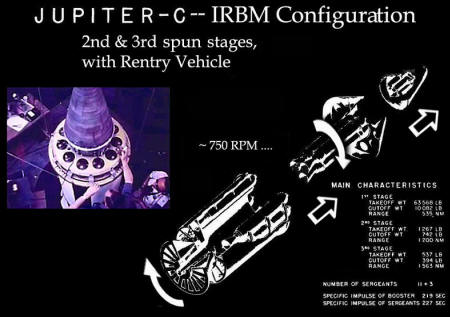
Von Braun and JPL (which designed this
rotating, solid-propellant upper stage configuration...), as Ludwig
wrote, simply modified their existing IRBM version a bit more,
adding a fourth solid-rocket upper stage (attached directly to
Explorer I) - which then became von Braun's "Jupiter-C satellite
launcher."
There - plain as day! - was the simple fact these upper stages
(called collectively "the tub") were all deliberately set spinning
just before launch... to provide (according to the JPL engineers...),
"gyroscopic stability against uneven burn of the Sergeant solid
rockets in each stage, during their subsequent ignition phases."
The added color inset (above - left) is a frame from a 1958 US Army
PR film - showing a top-down view of a one-third scale model of a
"nuclear reentry vehicle" for a forthcoming IRBM test, carefully
mounted on "the tub"; with the cover not yet in place, you can also
see clearly the placement of the 11 second-stage JPL "Sergeant"
rockets, mounted in their circular (waiting to be spun up... )
configuration.
The dummy warhead is the purplish "cone" on top of the (hidden)
third stage.
As Ludwig noted, this one-third scale warhead model was simply
replaced in the "satellite Jupiter-C configuration," by that
additional fourth stage solid-fuel rocket - atop which was literally
bolted the Explorer I satellite itself (below).

Here (below), JPL engineers work on a
full-size mock-up of this "spinning tub" assembly, with a separate
mock-up of the fourth stage and Explorer I on top - the full
"satellite version" of the Jupiter-C.

And here (below), is the three-stage
"rotating tub's" operational configuration - complete with the real
Explorer I - all mounted atop the conical "instrument section" and
(below that), the liquid-fuel main stage of the Jupiter-C booster
itself.
The vertical black stripe painted on the side of the "tub" is to
allow blockhouse engineers to optically monitor the rate of spin of
the three nested upper stages on the pad, as they were coming "up to
speed" (between 450 and 750 rpm...) just before launch.

So, precisely as predicted by the HD
model (and DePalma!) - a key section of von Braun's rocket, in fact,
did rotate that night... as it placed Explorer I into space!
Mystery of "the unexplained higher orbit"... finally... solved.
Well... not quite, of course, for, this "confirmation" only deepened the real mystery:
Why does "spinning" a steel pinball, or... rotating a one-ton,
high-tech "tub" - containing 15 solid rockets - allow both to climb
SIGNIFICANTLY HIGHER against gravity... than if they were NOT
spinning!?
One of the first reactions I had to this fascinating confirmation -
that portions of von Braun's rocket HAD to spin, inevitably (from
DePalma's experiment...) resulting in the higher orbit for Explorer
I - was a feeling of intense gratification for Bruce; for, this
simple engineering detail proved that Bruce DePalma has been
absolutely right all along... for over 34 years... in insisting that
"spinning a mass" also creates "some kind of anti-gravitational,
anti-inertial field..." which allows the object to fly higher
against gravity than if it was NOT spinning!
Von Braun - decades before Bruce DePalma ever conceived of his
elegant little "spinning ball experiment" - had already PROVED
Depalma right... with easily the most expensive "spinning ball"
demonstration one could possibly imagine (Explorer I cost the
American taxpayer
approximately 20 million dollars, in 1958; today,
allowing for inflation, that would be something like "half a
billion... ").
Further, it was now obvious that this is why von Braun also missed
the Moon... by those "pesky ~37,000 miles" with Pioneer 4.
Again he was using, in his Juno-2 "moonrocket" (a further
modification of the Jupiter-C...), EXACTLY the same "spinning tub"
arrangement for the four solid-rocket upper stages that he'd used in
the previous Earth-orbiting Explorer launches; and (from what we now
know...), the "DePalma Effect" struck again... neatly
over-accelerating the Pioneer 4 spacecraft to a slightly higher
velocity than JPL had calculated using only standard "Newtonian
dynamics"... thus, causing the spacecraft to arrive at the Moon's
orbit slightly sooner than it should have... passing ahead of the
Moon itself (which, of course, hadn't reached the "rendezvous point"
yet...) by those disappointing "37,000 miles (below)..."
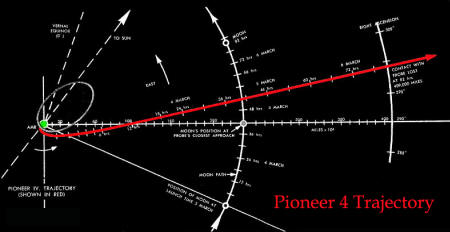
It all fit - beautifully.
Of course, the reason why simply "spinning an object" should so
dramatically change its "Newtonian dynamics" - against all current
mainstream theories (including, "sacred" Relativity...) - was still
as profound a mystery as ever...
It is hard to overstate both the scientific and political
significance of von Braun's initial Explorer I discovery (swiftly
confirmed, as we have documented, by Explorers III and IV, and all
three Vanguard launches!) - as well as all their confirmed
connections now to DePalma's totally independent, rotating
laboratory experiments.
Oh, did I forget to mention..., the US Navy Vanguard three-stage rocket also utilized a
solid-propellant in its third stage... so, it also
had to be spun
during the burn... for "stabilization" - at ~100 rpm (below)!

And, of course, then there was Allais...
ALL these independent, dynamical results revealed "huge, gaping
holes..." in conventional "Newtonian mechanics"... to say nothing
of what they did to "General Relativity!"
Yet, mainstream science -
and the mainstream science press, including those covering the space
program for the last 50 years - blithely went on... as if nothing
was amiss!
DePalma himself, trained as a mainstream physicist for decades at
two of the premier universities on the planet - MIT and Harvard! -
wrestled with the extraordinary implications of his "spinning ball
experiment" (first carried out in 1972...) for years - before
finally publishing some tentative, but
far-reaching conclusions...
"... the beginning of this author's
work with rotating objects began with moment of inertia
measurements of constrained gyroscopes undergoing forced
precession. The increased moments of inertia discovered for
precessional motion were translated into a series of
measurements on pendula with rotating bobs. Although the
discoveries of the inertial effects associated with precession
and pendulum oscillations of rotating bob weights were highly
suggestive, this author greatly resisted [for several years]
attempts to force him to drop a rotating object for two reasons.
"Firstly, he had no reason to be able to predict the motion of a
freely falling object on the basis of the inertial alterations
he had measured which had concerned themselves with constrained
situations of rotating objects. Second, there was no reason to
expect inertial alterations [because of Einstein's inviolate
"Principal of Equivalence"] to affect the rate of fall of a
released object and there was no available theory which could in
any way be applied to the situation or a falling rotating object
in a gravitational field. This is a situation known in religious
terms as a "leap into the dark."
"Since the author and his assistants are experts in the
application of stroboscopic lighting techniques to the study of
high speed motions, the first experimental cut at the situation
was to photograph the trajectories of a steel ball bearing
rotating at a high speed together with an identical
[non-rotating] control object moving at a similar initial
velocity. The result of the experiment was so startling and
anomalous as to have taken me five years to understand.
"... Basically, the spinning object going higher than the
identical non-rotating control with the same initial velocity,
and, then falling faster than the identical non-rotating
control, presents a dilemma which can only be resolved or
understood... on the basis of radically new concepts in physics
[distinct from the existing "Laws of Thermodynamics"...
"Newton's Laws"... or "Special and General Relativity"]...
"We know when we can alter the properties of mechanical objects,
i.e. change their inertia, we have contravened the conservation
of energy, because we have associated the properties of an
object with the space which contains the object. The space which
contains the object also contains energy and we can go at the
project in two ways: we can attempt to extract the energy
without worrying where it came from, or we can attempt to
understand physics, ourselves, and the Universe by a new
formulation of reality.
"... The behavior of rotating objects is explained [after much
thought] simply on the addition of free energy to whatever
motion the rotating object is [already] making. [Thus] the
spinning object goes higher and falls faster than the identical
non-rotating control.
"... In terms of the dropping of the spinning ball, the
understanding of the experiment involves the results of many
other experiments as well as the resolution of a mind picture of
the Universe which is our best approximation to understanding at
the present time. What makes it difficult for other
experimenters to understand the experiment is that it is not
simply the results which are important. Without a theoretical
foundation of understanding to make the experiment
comprehensible - to fit the results into a context of rational
understanding and harmony with the facts of other experiments -
the data become trivial and worthless, and, worst of all,
subject to misinterpretation.
"The [technological] availability of free energy from as simple
an experiment as colliding a rotating object with a non-rotating
one opens up the development of other machines for energy
extraction and propulsion which may be more convenient to handle
than the extraction of energy from the collision of a rotating
object with a non-rotating one..."

"... The behavior of rotating
objects is explained simply on the addition of free energy to
whatever motion the rotating object is [already] making. [Thus]
the spinning object goes higher and falls faster than the
identical non-rotating control..."
"Understanding the Dropping of the Spinning Ball Experiment"
Bruce DePalma
Simularity Institute
May 3, 1977
This summation of DePalma's thoughts on
the "spinning ball experiment" is, in my opinion, a significant
summation of the results of all of his decades of ground-breaking
experiments in "rotation."
It is also the key to understanding exactly what von Braun -
independently, serendipitously - actually discovered with Explorer
I... decades earlier... and then (for whatever reason) decided to
keep secret to the day he died...
For, after literally years of pondering its meaning - in concert
with all the other "rotation and inertia experiments" he had carried
out - DePalma, 25 years after Explorer (and knowing nothing of its
anomalies or its profound significance to his own work...),
realized that "the spinning ball" was NOT (directly, anyway...)
about "anti-gravity" at all.
That, instead, it represented a unique
window into a far deeper reality... re the very "energy structure"
of space and time itself... and the extraordinary possibilities of
extracting that unlimited, "free energy" via a variety of
"appropriate" technologies.
"Energy Crisis - Solved!" anyone...?
One of our unfinished, on-going discussions (abruptly cut short by
Bruce's tragic and untimely death, in 1997...) was a resolution of
exactly where this "free space energy" was coming from; in the "HD
Model," it is not really coming from "3-Space" at all - but
literally from "a higher dimensional reality," made available in
this dimension (as a propagating torsion field distortion - see
Chapter 2 in Dark Mission...) via "physical rotation of mass..."
The act of mere "rotation" - in the HD Model - literally "opens a
type of 'gate,' or 'geometric doorway...'" between other
dimensions...
Intriguingly enough, our decades-old debates also now provided
another (actually, "collateral"...) explanation for Explorer I's
"orbital over-performance"...
DePalma proposed, as a result of his wide-ranging rotational
experiments, that "rotating masses" in general set up some kind of
hitherto unrecognized "inertial field" in their vicinity (the more
widely-used term for this field now, because of how it's accessed,
is a "torsion field" - because "torsion" means literally
"rotation").
DePalma's exhaustive measurements (like the famous "Accutron
Experiment" - below) eventually revealed that this "torsion field"
was "anisotropic," i.e. it was NOT spherical (like a gravitational
or electromagnetic "bubble," decreasing sharply in intensity with
distance...) - but seemed to have radically different effects, and
different geometric properties, depending on the geometric
relationship and orientation of the detecting sensor to the axial
spin of the object being measured.
This new "spin field" (another
term now in use...) seemed to be, as scientists term it,
polarized...
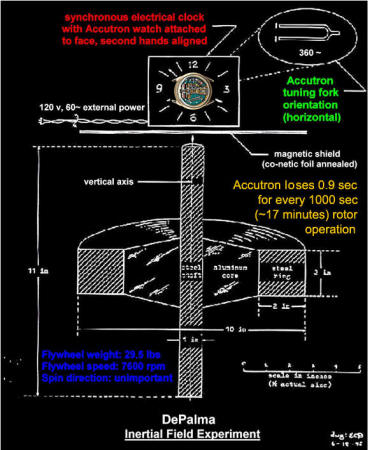
What this means is simple.
If measured along the rotational axis (as seen in the diagram -
above)... this "torsion field" from the resulting rotation seemed to
increase the inertia of other moving objects (such as the tuning
fork inside the Accutron); but, if the watch was rotated 90 degrees
(below) - into the plane of the masses rotation - the Accutron's
tuning fork inertia abruptly decreased...!

Again, these differences - measured
"within the spin field" - were NOT slight... or ambiguous.
A 1000-second measurement period (~17 minutes...) produced almost a
full second (0.9 sec) lag in the Accutron's previous time setting;
the normal drift rate of the watch - as measured by DePalma before
and after each experimental "run" - was about 0.25 second per a four
hour period...
The effect of a nearby, rotationally generated
"inertial field" on the Accutron's vibrating tuning fork - a field
created solely by spinning a ~30-lb aluminum/steel disc, at almost
8000 rpm - was definitely NOT "buried in the noise!"
As can also be seen in the above diagram, because the research of
DePalma's "Simularity Institute" was not funded by "lavish
government grants or major corporate donations...", sometime the
measurement technologies were ingenuously "improvised."
Unable to afford expensive "electronic frequency counters" to
measure the actual vibrations of the Accutron tuning fork, DePalma
did the next best thing with what he had; he physically attached the
Accutron watch to the face of an electrically-driven "Westclock"
(fed by 60 cycle, "AC line current" from the wall).
He then measured
the "time drift" of the Accutron, compared to the clock, by
physically synchronizing the two sweep second hands - the Accutron's
and the Westclock's - and then measuring how far apart their angular
positions were when a ~1000-second "rotor run" was finished!
Decades later, in 2004, I decided that Bruce's elegant Accutron-based
"inertial field detector" - if upgraded with a laptop and a
"computerized, crystal frequency calibration system" (easily
affordable now...) - would be the perfect sensor for a variety of
HD "torsion field" experiments and measurements for Enterprise.
Combining two previous experiments - DePalma's Accutron detection of
the "spin field" around a massive, spinning laboratory disc, and
Maurice Allais' detection (with a paraconical pendulum) of equally
"anomalous pendulum effects during the 1954 solar eclipse" (see Part
I) - I decided to attempt detection of potential "torsion/HD
effects" (if any!) generated from the impending Earth-Venus-Sun
alignment during the rare "Venus Transit" - to take place on June 8,
2004 (below).
This is an event, which happens only in "pairs" (separated by 8
years every 122 years ..!) - where Venus comes directly between the
Earth and Sun... essentially, a tiny, tiny "partial solar eclipse" -
caused by the shadowed side of a planet that's almost the twin of
Earth moving in-between these two other celestial bodies...

A friend and colleague,
Bill Alek - an
electrical engineer and computer systems expert, as well as an
Enterprise Associate - professionally assembled the required
equipment for our "Venus Transit Experiment" (see schematic -
below).
He even included ~150 feet of electrically shielded cable,
to isolate the Accutron from the quartz-crystal time standard (and
the laptop) we were using to gauge (to millions of times DePalma's
own measurement precision!) the Accutron's inertially-induced,
potential tuning fork vibration changes... during the actual
Transit.
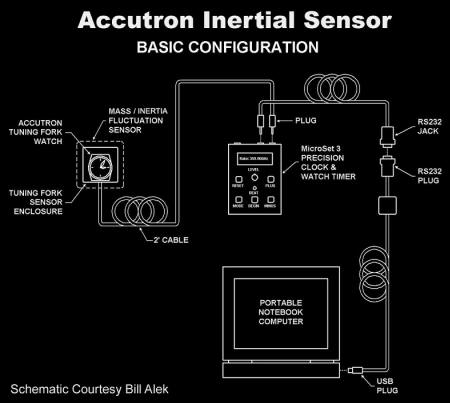
Bill's system (as you'll see...) worked
perfectly.
We decided to choose as our Transit location, southeast Florida's
famed "Coral Castle" (an entire story in itself!). We chose the
Castle, in part, because toward the very end of this particular
Transit, as Venus was about to leave the disc of the Sun... the Sun
itself would rise (for us...) over the Atlantic Ocean horizon!
And physical sunrise - according to our previous hyperdimensional
calculations - was a particularly propitious time to be measuring
the possible "torsion alignment effects" of the Sun... "rising over
the eastern horizon of a spinning Earth."
To make a LONG story shorter... the torsion/HD effects of Venus - as
it was physically departing the western edge of the Sun (as seen in
the Florida sky at dawn...) - were simply astonishing (below)!

Based on the major frequency "jump" of
the Accutron tuning fork occurring EXACTLY at the moment of 3rd
Contact (when Venus' edge just "kissed" the Sun's western limb -
above) - from ~360 hertz (cycles per second) to 364.5 hertz - the
extrapolated daily acceleration of the Accutron at that rate was
about twelve minutes per day!
For a watch normally rated (by Bulova) as "... accurate to a minute
a month."
Clearly... unquestionably...
"something" had reached out from Venus at the precise moment it was
geometrically projected against the visible edge of our closest star
- when, remember, Venus was ~25 million miles away from Earth - and
(somehow!) "touched " our little Accutron detector... with an
inertial change to its tuning fork fully one sixth of the same
effect DePalma had previously measured... when the watch was mere
inches from a massive ~30-lb steel/aluminum disc, spinning at 7600
rpm, in his lab!
Venus and the Sun - by means of their own extraordinary masses and
separate, but reversed, rotations (Venus spins backwards, remember...) - were obviously creating their own extraordinarily powerful,
interfering "torsional fields" - just as we predicted!!
Which (from the frequency plot - above) were clearly able to send
successive, "interfering waves" of torsion (note the descending,
"bell-like ringing"... as Venus fully "cleared" the Sun) to visibly
interact with, and change the inertia of, the tiny tuning fork
inside our Accutron!
It was an extraordinary and startling scientific moment of discovery
- a clear, measurable demonstration of the reality of DePalma's
rotationally-induced "inertial/torsion fields." But, more than that,
it was a vivid confirmation that outside the lab... celestial
"planetary alignments" of major members of the solar system (Hyperdimensional
Astrology, anyone...?) can and do have extremely powerful - and
physically measurable - effects on Earth...
If you have the correct physics model... and the right detection
equipment!
As I watched the Sun rise over the edge of the Atlantic - with tiny
Venus (remember, the size of the Earth ..!) just dimpling its
western edge, and, unbelievingly, simultaneously watched the
computer screen trace the invisible "torsion field" interactions
between Venus and the Sun at that same moment - I couldn't help but
wonder...
"What would Bruce think about this amazing confirmation?!"
DePalma had a quirky sense of humor, perhaps best revealed by his
naming of this mysterious "inertial field"... the "OD field."
Thinking of DePalma at that remarkable moment, I couldn't help but
also think "how odd... that he's not here to share this."
However,
as Depalma had observed himself years before, the resulting
influence of these "OD field" effects - be it from spinning
laboratory discs... rotating planets... and even massive stars (!) -
is NOT limited to mechanical objects, like "tuning forks"...
As he noted...
"...the effect of a field which
confers inertia on objects immersed within it can be applied to
a number of [other] situations, not all of which have to be
mechanical, i.e. chemical reactions are [also measurably]
affected by such a field. Reactions which do not take place
under 'normal' conditions may be catalyzed. Other reactions may
be inhibited..."
Returning us to the problem of von
Braun's "anomaly."
Confirmation of DePalma's projected "OD field chemical effect" (to
use his term...) raised the fascinating prospect that the physical
act of rotating those upper rocket stages of the Jupiter-C had also,
somehow, altered the physical chemistry of the solid rockets in
those upper stages! This, in turn, could have markedly increased the
efficiency of their previously estimated thrust and/or ISP!
More precisely...
That their physical rotation (ala DePalma...) had significantly
altered what was occurring at the moment of ignition - by triggering
a fundamental enhancement of the rockets' chemical reactions...
during the actual burning of the solid propellants!
Remember DePalma's previous analysis, that,
"...the behavior of
rotating objects is explained simply on the addition of free energy
to whatever motion the rotating object is [already] making..."?
What if, as DePalma theorized, this fundamental "free energy"
addition also extended down to the atomic and molecular levels?! What if the "addition of energy" - to whatever motions are occurring
within "the OD field" of a rotating system - also automatically
enhances the thermodynamic efficiency of reactions occurring at the
molecular and atomic levels in that system!?
In other words:
what if the sheer rotation of those solid-propellant
upper stages, by being enveloped in their own "OD field,"
substantially increased their ISPs... and thus, their effective
thrust efficiencies?!!
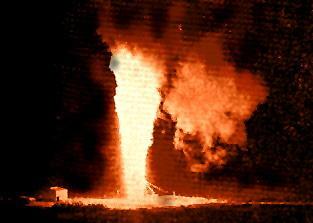
Could "Von Braun's Secret" that night
have involved far more than just a blatant violation of "Newton's
Laws..." (as serious as that obviously was...) caused by an
inertial change in those upper stages created by "rotation?"
Could
"the Secret" also have encompassed an almost trivial means of
tapping directly into unlimited "free energy" for ANY chemical
reaction - by the simple act of rotation...?
As should be readily apparent to anyone thinking deeply about all
this, von Braun himself clearly (if inadvertently) had tripped over
"a vast source of
free energy in space..." - simply in those
mysteriously enlarged "satellite orbits" - regardless of the details
of how he actually did it... which "they," for obvious reasons (Big Oil, anyone?), immediately
suppressed...
Imagine what the world would look like now... in 2008 - half a
century after these historic events... if, instead of being
immediately hidden, this extraordinary discovery had been
triumphantly announced within a few days by the Eisenhower White
House... and then, made openly available to scientists and engineers
around the world... even in the former Soviet Union.
Would we even recognize our planet now...?
With our clear identification of Explorer I's "non-Newtonian
anomalies" as being due to the rotation of the launch vehicle's
solid-rocket stages, the celestial-mechanics "fix" for future US
space missions - including the Apollo Program - was as simple as it
was obvious:
DON'T rotate!
So, the fascinating question then becomes: "when" did von Braun and
JPL also come to this critical conclusion?
In other words, when did they "figure out" (regarding Newton's Laws...) what Bruce DePalma, independently, would also realize through
experiment...
two decades later?
"The fact that Newton’s Laws do not
distinguish between the spinning and the non-rotating object
represents the state of mechanical knowledge at the time. But
because Newton did not distinguish between rotation and
non-rotation, Einstein did not distinguish between the so-called
inert and 'gravitational mass.' The fact that rotation affects
the mechanical properties of objects places Newton’s Laws as a
special case and invalidates a geometrical [Einsteinian]
interpretation of space.
"… in a strict sense, the precise application of Newton’s laws
[based on these experiments] … have to be restricted to
non-rotating mechanical objects in field-free space. In a
gravitational field, the possibility of extraction of greater
energy by a new mechanical dimension [rotation] opens up the
possibility [against both Newton and Einstein] of an
anti-gravitational interaction...”
"Gravity
& The Spinning Ball Experiment"
Bruce DePalma
Simularity Institute
March 17, 1977
So, von Braun and Pickering eventually
realized that, if you wanted a spacecraft to follow predictable
Newtonian celestial mechanics - in Earth orbit... going to the
Moon... or traveling anywhere Beyond..., rule One - don't let it rotate!
As we described in Part I, this now explains JPL's (as viewed at the
time...) "highly risky sudden spacecraft engineering decisions..."
to abandon well-tested spinning system concepts (used in JPL's
previous Explorer series...), and to severely "push the envelope" -
to embark on a radically new type of spacecraft construction...
pioneered in (what would soon become...) "the ill-fated,
problem-plagued, Ranger Lunar Program":
A Program attempting to make available to US space planners, for the
first time "...a three-axis, non-rotating, fully stabilized
spacecraft design."
Seen against the serious space navigation problems of the
"non-Newtonian anomaly" (that JPL was also obviously racing the
clock to try to "figure out"), this risky engineering decision, in
hindsight, now makes perfect sense.
So, the question looms... again:
"when did JPL first realize that
rotation was 'the enemy?'"
To answer that key question, we must go back once more in time... to
before the shock of Sputnik.
Bill Pickering was named Director of JPL in 1954.
Immediately upon Pickering's appointment, as part of his own
long-term agenda to turn JPL "into the premiere space laboratory in
the world..." the new Director began pushing a plan to the Pentagon
(the only agency funding "space" in those pre-Sputnik days...) for
an unmanned lunar probe, called "Project
Red Socks" (and, try as I
might, I cannot find out where this name originated! As an emigrated
New Zealander, I'm convinced Pickering was NOT a fan of "a certain
Boston baseball team..." so, the origin of this proposed name
remains... obscure).
In an era when the idea of just launching "a satellite into orbit...
" was viewed by Washington as "still one step removed from science
fiction..." (remember, this is why the "Jet Propulsion Laboratory"
- which never built a "jet," but designed only rockets in its early
years - decided to use the more "acceptable" designation "jet" in
all its contracts with the Army...)...
Pickering's idea went... nowhere.
Then...
Sputnik happened.
Pickering promptly resubmitted "Project Red Socks" (which, by then,
had morphed into an entire "JPL unmanned lunar program...") to the
Pentagon.
Again, it went nowhere...
Until... months later... the newly-formed
ARPA suddenly latched onto
the idea, renamed it "Project Pioneer," and split the program (and
the contracts) between the US Air Force and the US Army (with JPL
getting the job of building the Army's lunar version...).
What's fascinating about "Red Socks" is how Pickering was originally
proposing to send an unmanned spacecraft to the Moon... and get it
back.
For, in his design, the spacecraft was to carry a high-quality
reconnaissance camera loaded with film (no "television")... which
would loop around the Moon (red line - below), acquiring
photographic-quality images of the entire "hidden side"... before
physically returning to Earth, reentering... and then being
retrieved - so that the film could be developed and physically
examined at JPL!
(Two decades later, the Soviets would do EXACTLY that... with Zond
5, in late 1968. And - they'd use "Eastman Kodak film" to do it!)

Pickering built his proposal around von
Braun's parallel development (discussed earlier...) of a
"survivable reentry vehicle" for a nuclear warhead, yet to be tested
(in 1954) by a Jupiter-C IRBM (below).
This indicates the extremely
close working relationship between Bill Pickering and Wernher von
Braun, long before Sputnik and Explorer (note the 11 Sergeant
rockets visible in this photograph, down through the holes in the
top of the Jupiter-C's rotating "tub" - just below the one-third
scale model of the reentry vehicle itself).

However, there was one major detail
about "Project Red Socks" which, in hindsight, could make one
question what von Braun and JPL really knew about the entire
"non-Newtonian anomaly"... and, when they knew it.
This detail
centers on that fact that, if it had been funded, Pickering's "Red
Socks" proposal would have encountered exactly the same
"non-Newtonian problem"... and for exactly the same reasons... as
Explorer, Vanguard and Pioneer...
For..., as you can see from this artist's concept (below), the Red Socks
design also featured "a ring of solid-fueled rockets, surrounding a
single upper stage..." - to which the camera-carrying lunar
spacecraft would have been attached...

EXACTLY...
Like the later Explorer I and Pioneer Jupiter-C configurations -
with their own "spinning upper stages," and "spacecraft bolted to
the final rocket!"
Here (below ) is the startling visual comparison; on the right, Bill
Pickering (in 1992), holding a plexiglass model of Explorer I.
In the background of the same photograph (to his left - with
cylindrical housing removed...), a scale model of the upper stage
"spinning tub" of von Braun's Jupiter-C satellite launcher, with the
Explorer satellite attached.
Note again, the circular placement of
the 11 "cut-down Sergeant rockets" of the second stage, and the
conical housing of the third stage (hiding its three additional
cut-down Sergeants) protruding from their center... to attach points
on the solitary fourth stage - with the (thermally-striped) model of
Explorer I on top.
The comparison graphic (below-left) is Pickering's earlier "'Red
Socks' upper stage and lunar probe configuration..."

Eerie...
Pickering was (obviously) "playing to
JPL's own unique history" with
his 1954 proposal - the solid rockets that, up until that point, had
formed the foundation of JPL's entire reputation... the solid
rockets that
Jack Parson's had successfully created, decades
earlier... for a laboratory which (some still insist...) actually
bears the initials of his name, because of that singular,
far-reaching contribution to the American space program...
And, though it's not overtly stated by any sources I could find,
Pickering's plan to use an array of these solid rockets to send a
camera to the Moon would have automatically demanded that they also
spin - otherwise, the unbalanced thrust of their individual
variations (as we have seen...) would have sent the proposed lunar
spacecraft careening wildly off-course... the same reason that the
upper stages of the Jupiter-C (and the Juno-2 lunar version...)
also had to spin.
But, looking at these (essentially...) identical upper stage
configurations, I couldn't help but wonder once again...
"What did Bill Pickering (or, his
JPL engineers...) really know - and when did they first know
know it... about the other effects of such an upper stage
rotation?"
For, while working on ever larger
versions of Jack Parson's solid-fuel rockets after WWII (below),
even then some JPL engineers were
looking upward... toward the
Moon...
"... the most famous JPL product of
that time was a small-scale prototype of Corporal called WAC
Corporal (Without Attitude Control), some of which were used as
a second stage of [the] V-2, reaching altitudes of more than 400
km and inaugurating, on [sic] 1950, the Atlantic coast missile
range which became the Cape Canaveral 'spaceport.'
While working
on this historic project, some laboratory engineers calculated,
as a joke, that by using the full scale Corporal missile and a
cluster of anti-aircraft Loki solid-fueled rockets, it was
possible to hurl to the Moon... an empty beer can!"

With a spinning upper stage
configuration, as we now know, that "empty beer can" easily could
have grown... into a full-fledged camera-laden mission!
So, when did Pickering first realize that the "secret" to
significantly increasing the ISP efficiency of his JPL solid-fueled
rockets (and thus, their payloads) was just... to "spin them!?"
And - when did he first tip off von Braun...?
From the "spinning technology" of
the mysterious Nazi Bell, to the
"spinning upper stages" of Pickering's aborted "Project
Red Socks,"
to Pickering's extension of that same "spinning technology" to the
upper stages of von Braun's own Jupiter-C launch vehicle itself...
rotation seemed to professionally surround von Braun at every turn
(sorry...).
Yet, after the startling anomalies of Explorer I, von Braun himself
seemed profoundly shocked, if not genuinely confused, by the
dynamical behavior he was observing. What did he do then?; he began
secretly writing to key experts around the world, to anyone who
might have a clue as what had really caused Explorer I's (to him...) "inexplicable behavior."
Not exactly the actions of "someone in the know."'
So, did either of them - Pickering or von Braun - know, before
Explorer I, what was really going on?
In my professional opinion - based on this extensive research into
von Braun's actions following Explorer's launch (and Pickering's
equally documentable, independent, Herculean efforts to overcome -
with an entirely new type of spacecraft - the "non-Newtonian
anomaly" in the wake of Explorer I...)..., no... neither man... knew anything!
Life is simply full of "irony and strange (some might even say 'hyperdimensional')
coincidences..."
The fact that Pickering's "rotating solid-rockets" were the only
available means - both to an early satellite launch into Earth
orbit, and to early efforts to send a US spacecraft to the Moon,
and, that in order for them to work as advertised, they had to spin
- is, in my opinion, just exactly that:
A remarkable... almost providential... historical...
coincidence.
The fact is that von Braun had to choose Pickering's "rotating,
solid-rockets"... if he wanted, at that point of US technological
development, to successfully launch anything!
And, if all this hadn't been just "sheer coincidence"... JPL
wouldn't have immediately undertaken the almost impossible task of
creating an entirely new space technology, after Explorer I - a
non-rotating lunar and planetary spacecraft "bus."
And, von Braun
wouldn't have held out for four full years (as we noted in Part I),
before suddenly, without any prior warning, reversing his previous
position and approving "LOR" for the Apollo Program... after he (we
believe, from all the evidence) finally got the word that JPL had
"fixed" the "non-Newtonian problem."
However, all that said... it is this remarkable set of "conspiring
coincidences" that has now given us a stunning new set of blatant
clues - "...those mysteriously enlarged, totally revealing,
satellite orbits of the Earth..." (that no one can successfully
suppress much longer) to the almost unlimited potential for HD
Physics... right here on Earth...
To truly change the world...
So, just how certain am I that these remarkable HD "rotational
effects" can now account for the all flagrant Explorer, Vanguard and
Pioneer satellite anomalies?...
About ninety-nine percent...
Because..., there were subsequent instances of these same "HD rotational
effects" observed in the continuing Explorer Program, which
reinforces the idea that it was also due to this same "anomalous
physics"...
George Ludwig - Van Allen's chief assistant (and designer of all the
electronics for the radiation detectors carried in the Explorer
spacecraft) - wrote a remarkable
personal description of one
fascinating... and now quite telling... subsequent "incident." It is
clear, however, that he too obviously had no idea what he was
actually witnessing...
Wrote Ludwig:
"... my Journal also reported... the
most serious problem from my point of view... the difficulty in
commanding playback of the [spacecraft's on-board] tape
recorder. When the spin-up of the upper rocket stages was
started at X-11 minutes, the recorder operated normally at
first. But by the time the spin rate reached 550 revolutions per
minute (out of 750 rpm needed for flight) we were unable to get
a response from our radio commands for playback. The Launch
Director interrupted the spin-up, slowed it down, and then
increased the rate gradually. Playback was successful at 450 rpm
but not at 500.
"All of this was happening within the final minutes of the
countdown, while the rocket sat there fully fueled and ready to
go. The pressure for a final go/no-go decision was intense, as
further delay would have meant canceling the launch for that
evening and recycling for the following day or later. While we
held up the launch for 18 minutes, the payload manager, other
payload engineers, and I had a spirited discussion, and
concluded that the problem was with the on-pad commanding link,
not the recorder itself. Specifically, we believed that there
was a problem with the grounding path for the interrogating
signal, and expected that operation would be normal once the
rocket was free of the cluttered pad environment. We all agreed
to proceed based on that assessment.
"The official launch time was 1:28 PM, EST on Wednesday, 5 March
1958. Performance of the Redstone first stage booster rocket
appeared to be normal throughout its burning. Later analyses
indicated that the firing of stages one, two, and three were all
normal. However, the fourth stage apparently failed to ignite,
for reasons that were never completely determined, and the
launch attempt failed. The satellite payload plummeted into the
Atlantic Ocean about 1900 miles downrange from Cape Canaveral
[emphasis added]..."
By his own admission, Ludwig's dismissal
of the pre-launch "tape recorder problem..." - as "merely radio
interference from the clutter on the launch pad," exacerbated by the
high-pressure "go/no go" pre-launch environment - unfortunately
encouraged the collective decision to "just resume the count and
launch..." without taking the time to properly analyze the
situation.
Which, unfortunately, resulted in the subsequent loss of
the entire spacecraft "for reasons that were never completely
determined..."
Decades later, through another of his remarkable "rotational
experiments," DePalma would (again!) expose the real "HD Physics"
behind what likely happened to Explorer II.
Following DePalma's many experiments - that had increasingly
verified the existence of a remarkable, uniquely geometric "OD
field" around all massive, spinning objects (and even small ones...) - DePalma naturally began to wonder about the effects of such
an "inertial field" on non-mechanical systems... specifically, on
complex electronics... like "an off-the-shelf FM stereo receiver"
(below).
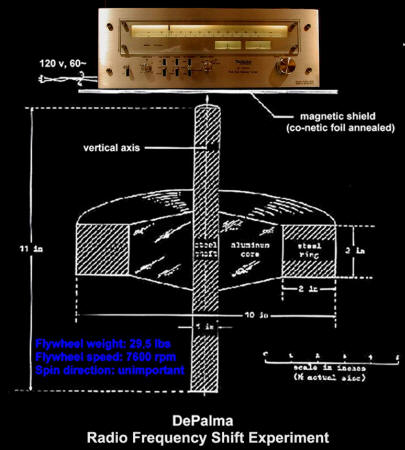
Here's DePalma's description of an
experiment he neatly carried out, to determine what those effects
actually might be...
"... because of the uniqueness of
the [OD field] behavior, corroboration [of an electronic effect]
was attempted in the form of an experiment to alter the tuning
of a radio-frequency circuit oscillating at 106 megacycles
[megahertz]. The expected effect did indeed take place with a
frequency shift measured to be about 2500 cycles [2.5 parts in
10(5)] relative to an oscillator located remotely at a distance
of 70 miles and communicated to it by radio [emphasis added]..."
"Simularity: a New Theory of Physical Phenomena"
Bruce DePalma
Simularity Institute
June 15, 1973
The results of DePalma's "inertial field
radio experiment" are illustrated below.
The frequency plot of the received FM signal, when the ~30-lb,
aluminum/steel disc was NOT rotating, is displayed as the
essentially horizontal "noisy" white line on the bottom of the graph
(lower right). The frequency of the received signal when the disc
was spinning (at ~8000 rpm...) is displayed in yellow (upper
right).
An artistic rendition of the FM transmitter is on the left.
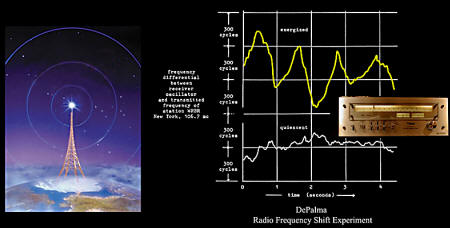
The fact that the distantly transmitted
signal (when the receiver was "within the field" of the rotating
disc in Depalma's lab) seemed to have a semi-regular "frequency
periodicity," indicated that the generation of an "OD field" by
physical rotation was also NOT a "static phenomenon"... but seemed
to have multiple, drifting, interfering frequency components of its
own - which resonated (in some, still undetermined fashion...) with
the receiver's own electrically resonant circuits...
Exactly like what we saw - when measuring (with the Accutron...)
the "OD field" from Venus, "interfering with" (modulating...) the
Sun's much greater "OD field" (below)!
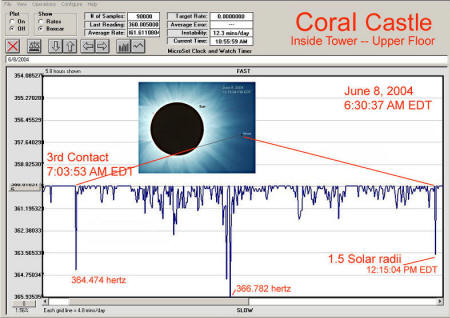
DePalma (remember, an MIT/Harvard
electrical engineer...) described his first impressions of the
"radio shift experiment," based on the "variable inertia" model,
thus...
"...the radio frequency shift
experiment demonstrates the existence of a phenomena, created
here on Earth, which can alter the frequency of an oscillating
circuit, independent of any electro-magnetic interaction. The
phenomena of electrical resonance is created through the
interaction of inductance and capacitance existing in what are
known as lumped circuit elements.
As these are real physical
objects, we should expect that any field or effect which altered
the inertial properties of the materials from which these are
made would affect the frequency of vibratory electrical
resonance..."
Later, as we have seen, DePalma
rethought some of these initial assumptions - and moved from "the OD
field/torsion field creates a true variable inertia in physical
objects," to a model which invoked the field's ability "to channel
energy from the vacuum" (hyperspace!) into existing energy processes
already occurring in these 3-D objects...
In that model, the effect of the "rotational OD field" on the stereo
receiver's circuits could be viewed as directly altering either
their voltage, reactance or amperage (or, all three!)... leading, in
the end, to the same rhythmic, resonant frequency changes that were
observed...
Whatever the ultimate physical process (and, unfortunately, DePalma
never had adequate resources to determine what that might have been...) the fact that an "OD field" - from an EM shielded, spinning
laboratory disc - could significantly affect the electrical
circuitry of an off-the-shelf stereo receiver placed within mere
proximity, has extraordinary, far-reaching implications...
Including... for the failed attempt to launch Explorer II!
Clearly, Ludwig's Journal description of what occurred, as "the tub"
was gradually spun up to its rated "750 rpm for flight," and the
failure of the tape recorder (newly added for this mission) radio
commanding circuits suddenly occurred "above 500 rpm..." is
compelling evidence that it was the ROTATION of "the tub" which
(somehow...) was "the problem."
However, completely lacking ANY appropriate physical theory (unlike
us...) as to how a physically rotating set of rockets could
possibly affect the radio circuits of the Explorer II spacecraft,
the Launch Director (with Ludwig's grudging concurrence...) decided
to proceed..., with the unfortunate, disastrous consequences.
It doesn't take much extrapolation from DePalma's historic "radio
frequency experiment" - carried out within the powerful torsion
field of his rotating laboratory disc - to envision what happened to
Explorer II; somehow, the "torsion field" created by the spinning
"tub" above 500 rpm, altered the electrical properties of the
on-board tape recorder radio circuits just enough... to interfere
with their ability to carry information reliably to and from the
ground.
Unknown to the launch team, these same "inertial field effects"
likely were ALSO interfering simultaneously with the firing circuits
of the fourth stage itself [perhaps, because of physical proximity
of both sets of the wires leading to the tape recorder in the
satellite, which (remember) was physically bolted to the top of the
fourth stage]!
Clearly, in light of DePalma's definitive radio experiment (and at a
frequency only slightly different than Explorer's 108 megahertz!),
the evidence is heavily in favor of "an HD Physics cause" for the
subsequent inability of Explorer II to successfully reach orbit...
The first compelling case for a truly "hyperdimensional failure" in
the US space program!
Which brings us to the little matter of "the Soviets."
Unlike the Americans, because the USSR was using BIG converted ICBMS
(Korolyov's "R-7" boosters - below) to put their
"several-thousand-pound satellites" into Earth orbit [or to send
their first, almost half ton (!) unmanned lunar probes toward the
Moon], they didn't have to rely on "marginal clusters of solid
rockets" in the final stages, to "barely put up a few-pounds..."

Ergo... they didn't have to spin their
boosters!
So, why - with a liquid fueled (kerosene and liquid oxygen),
non-spinning "Block E" third stage - weighing over a ton itself, and
directed to the Moon by a set of sophisticated "state-of-the-art,
radio interferometry navigation beams" from Earth...
Why, with all that going for them... did the Soviets still miss the
Moon on their first try by those "~3700 miles!?"
And why, ten months later... did they then "get it right" (somehow)
and squarely hit it?
The answer to that fascinating question which, on the face of it,
would seem to undercut our entire thesis in this paper - that, to
invoke HD Physics and the "non-Newtonian anomaly" in celestial
navigation, requires that some part of the booster rocket spin...
Is, in fact, the visible exception... "that proves the rule."
Because, again - drawing on the actual HD experiments conducted by
DePalma - we've even been able to figure out the answer to that
mysterious little Cold War question:
The key to solving this remaining "celestial-mechanics mystery" is
in this little gem from Bruce DePalma,
once again...
"...mechanical energy of motion,
stored in the created inertial property, od, appears as an
inertial field. This inertial field has the property of
conferring inertia on surrounding material objects - and a
reduction in the frequency of oscillating electrical circuits
placed in the vicinity of the energized machine..."
Think.
Even in non-rotating spacecraft... in their boosters... in their
"instrument units"... what is the one thing which is always rotating
- even if the vehicles do not.
The gyroscopes.
All spacecraft (and their associated launch vehicles...) have to
have a number of whirling gyroscopes in their on-board "inertial
navigation systems." These devices literally steer the vehicles,
providing on-board 3-D coordinates for ground-based navigation and
(along with other on-board devices, called "accelerometers") provide
absolutely critical reference points for any spacecraft trying to
reach any distant destination...
The gyros always have to spin!
Back to DePalma...
"…the [inertial altering, OD field]
effect is roughly proportional to the radius and mass [of the
rotating object] … and to the square of the rotational speed...”
So, if you have a big "dumb" object -
like a main stage booster, or a set of upper stages - and you spin
them... you get a certain "OD Effect," depending on how fast they
rotate.
But, if you have a set of tiny, low mass objects - the gyroscopes in
the on-board inertial navigation systems - but you spin them "like
the proverbial bat out of hell..." you can get a MUCH greater
proportional effect..., because - their individual torsion fields are directly proportional
to the square of their individual rates of spin!
The key is in DePalma's crucial observation,
"...this inertial field
has the property of conferring inertia on surrounding material
objects."
What happened to the Soviets was elemental:
The torsion fields of the internal, spinning
gyroscopes - rotating
upwards of ~100,000 rpm - conferred their torsion field effects to
the larger vehicle... causing it to drift off a "straight Newtonian
trajectory"... across ~240,000 miles... by just enough to miss the
Moon by that "... 3700 miles."
By Luna-2 (ten months later...) the Soviets had obviously "figured
this out"... and, made the appropriate "mid-course corrections"
enroute to the Moon.
Which then allowed them, to hit the Moon "dead on!"
Which leaves only the future technological effects of this
extraordinary discovery on the quietly developing private space
programs trying to "get off the ground" - Burt Rutan, Sir Richard
Branson, Elon Musk, etc., etc., etc.
And, how this same technology can also
now be used to dramatically improve the "everyday lives" of everyone
on Earth!
|






































































